GEN DE ART



ART BASEL BASEL 2025 アート・バーゼル バーゼル 2025
Art is potential アートは可能性である
PICASSO FOR ASIA—A CONVERSATION ピカソ─アジアとの対話
A Monumental Cultural Dialogue at M+ M+で実現した記念碑的な文化対話
YOSHITOMO NARA 奈良美智
A Journey Through Gaze, A Chronicle of Emotion 奈良美智展、ロンドンにて開催中
YOKOHAMA MUSEUM OF ART 横浜美術館
A Hub Connecting the City's Past and Future Through Art 歴史と未来をつなぐアートの拠点
KOHEI NAWA名和晃平
Weaving Space, Bridging Worlds 空間を編む、世界をまたぐ
39 43 49 55 65 69 75 77 81 87 93
FONDATION CHU TEH-CHUNフォンダシオン チュー・テチュン Legacy in Motion 継承という名の動き
NOBEL PRIZE DIALOGUE TOKYO 2025 ノーベル・プライズ・ダイアログ東京2025
The Future Begins with Dialogue 未来は、対話から生まれる
BMW ART CAR SERIES アート・カー
A Fusion of Performance and Creativity コレクション性能と創造性の融合
WATCHES AND WONDERS GENEVA 2025
The World’s Greatest Celebration of Time ジュネーブが刻んだ美しき革新
PATEK PHILLIPPE パテック フィリップ
The Enchanted Oracle 魔術師の書
LEICA WATCHES ライカWATCH
Exploring fluid artistic identity in a globalised world グローバル化時代における芸術表現
TAKAY SOLO EXHIBITION “TESSERACT”
A New Artistic Realm Capturing the Energy of the Moving Body 瞬間の身体の動きとエネルギーを切り取った新たなアートの世界
FESTIVAL BEETHOVEN À BEAUNE
Burgundy wine meets classical music in stunning French vineyards ブルゴーニュのワインとクラシック音楽が美しい葡萄畑で出会う
DOMAINE DUGAT-PY ドメーヌ・デュガ・ピィ
The Quiet Excellence 時を宿す静謐
NADINE GUBLIN ナディーヌ・ギュブラン
A Portrait of the Winemaker Who Brought Reason to Burgundy ブルゴーニュに理性をもたらした女性醸造家の肖像
MAXIME FRÉDÉRIC AT CHEVAL BLANC PARIS シュヴァル・ブラン パリで紡がれる
The Poetry of Pastry マキシム・フレデリックの菓子詩







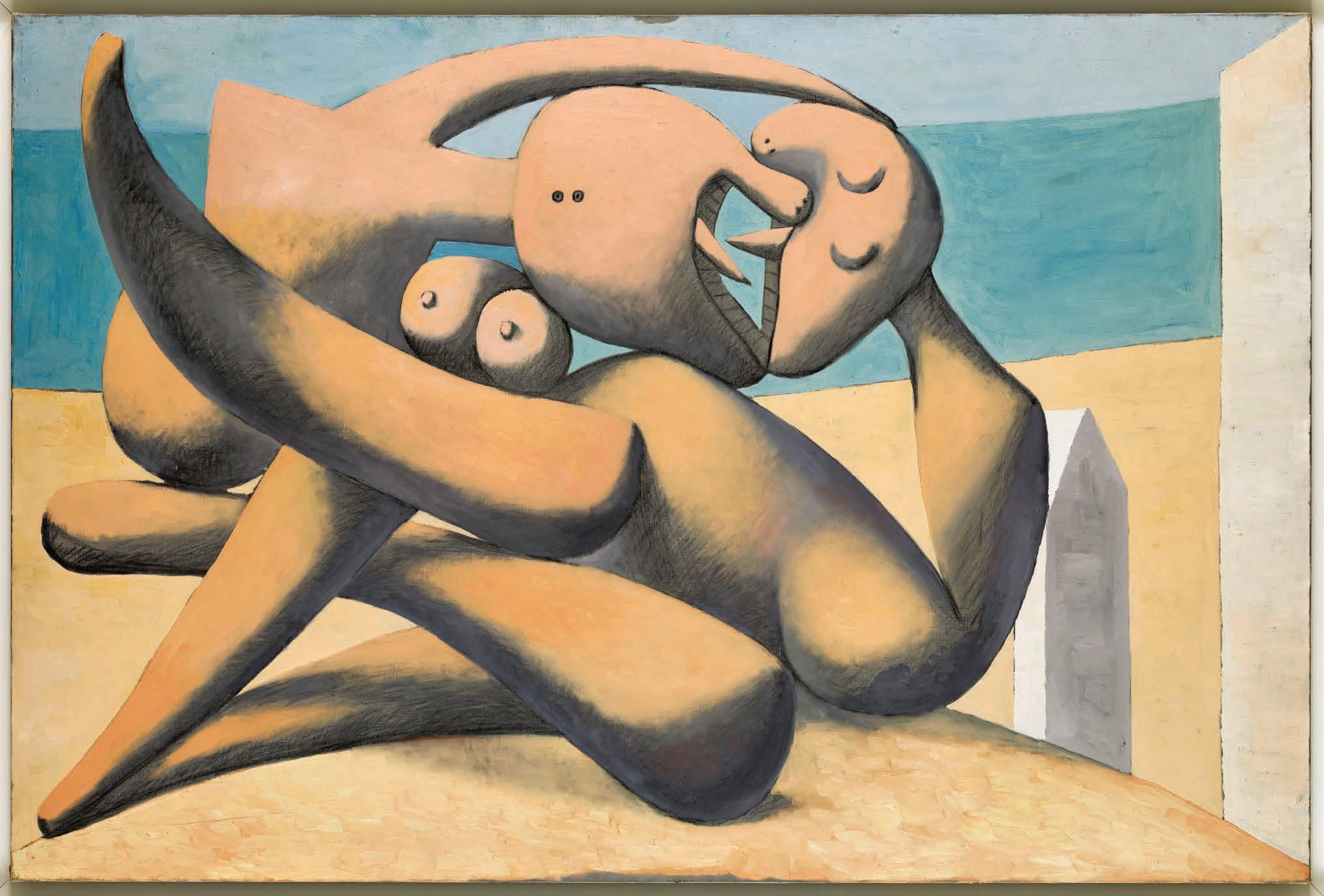




As the global art world eagerly anticipates one of its most prestigious events, Art Basel Basel 2025 promises to be a dynamic confluence of established masters, emerging talents, and groundbreaking ideas. In a revealing conversation with Maike Cruse, the show director for Art Basel in Switzerland, we gain rare insight into the curatorial vision and evolving cultural dynamics shaping this landmark edition, as well as its thoughtful embrace of sustainability and digital innovation.

世界のアートシーンで最も注目され るイベントのひとつである「アート ・バーゼル・バーゼル2025」が、今 年も革新と対話に満ちたプラットフ ォームとして幕を開ける。本展のス イス版ディレクターであるマイケ・ クルーゼ(Maike Cruse)との対話 を通じて、この記念すべきエディシ ョンに込められたキュラトリアル・ ビジョンや、文化的潮流と技術的革 新がどのように交差しているのかが 明らかとなった。
“This is my second year leading Art Basel’s flagship show in Switzerland,” Cruse explains. “For the 2025 edition, we are presenting a bold and forward-looking program shaped by innovation, diversity, and global perspectives.”

The fair features 290 galleries from 42 countries and territories, a comprehensive showcase of
modern and contemporary art. Among the new developments is the Premiere sector, designed to spotlight pioneering works created within the last five years by up to three artists. “This platform shines a spotlight on the freshest voices shaping contemporary art today,” says Cruse, underscoring the fair’s commitment to discovery.
革新と多様性に根ざしたキュラトリアル・ビジョン
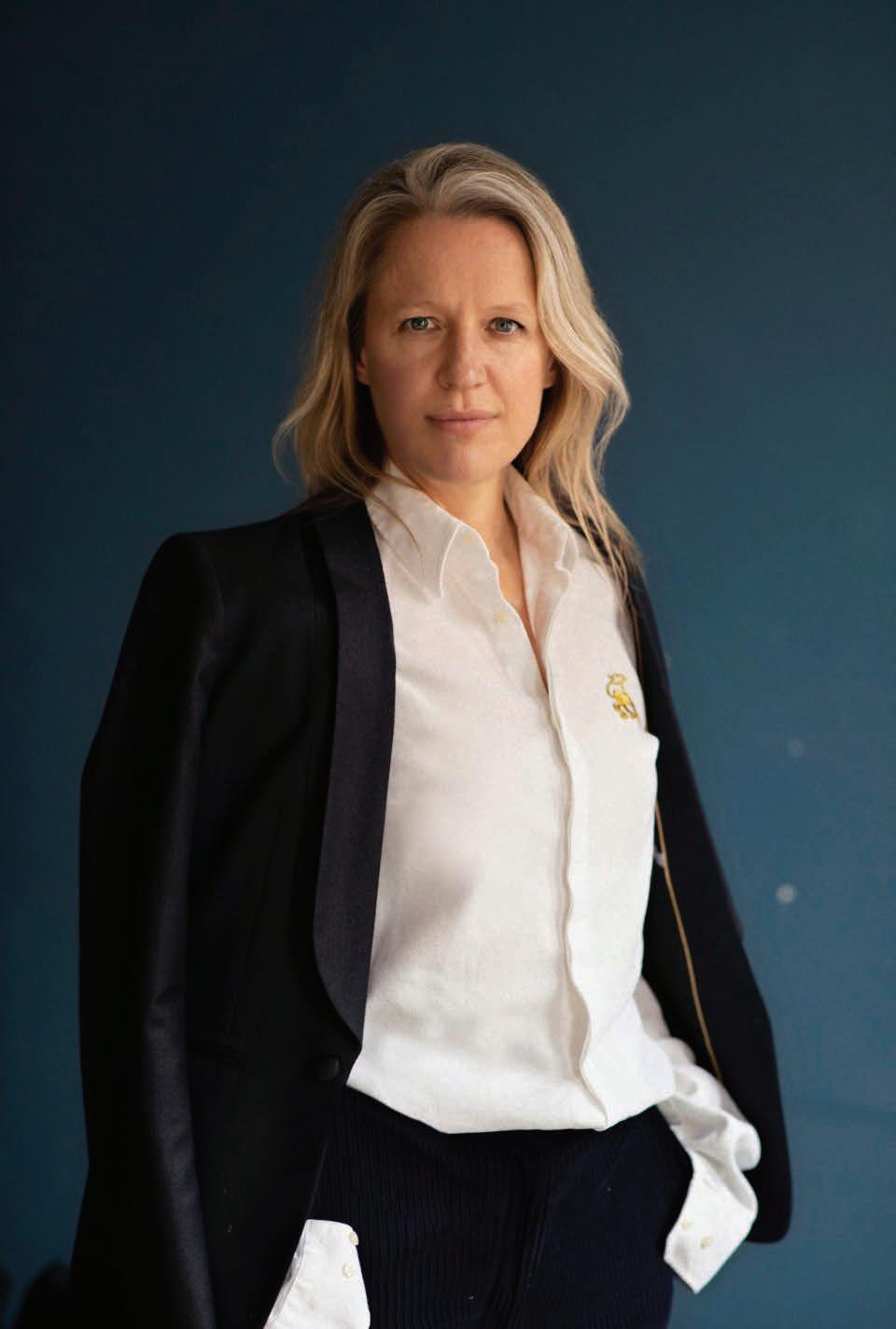
Adding to this rich tapestry, 20 new galleries hail from major art centers like Los Angeles, Paris, and London, as well as emerging hubs such as Lugano, Tbilisi, and Toronto. Notably, three Japanese galleries—including Kayokoyuki, Kosaku Kanechika, and The Third Gallery Aya from Osaka—bring unique perspectives; the latter will present a classical photography exhibition featuring trailblazing female photographers Yamazawa Eiko, Okanoue Toshiko, and Ishiuchi Miyako.
A highlight of the public experience is Katharina Grosse’s large-scale chromatic installation at Messeplatz. Curated by Natalia Grabowska of the Serpentine Gallery, Grosse’s immersive spray-painted environment promises to be a striking visual and conceptual centerpiece, blending site-specificity with sensory impact.

「今年は私にとってスイス本展のディレクターとして2 年目となります」とクルーゼは語る。「2025年のエデ ィションでは、革新性、多様性、グローバルな視座を 軸に、より挑戦的で未来志向のプログラムを構築しま した。」
今回は42の国と地域から290のギャラリーが参加し、 現代美術と近代美術の広範なビジョンが展開される。 なかでも注目すべきは、過去5年以内に制作された新 作を最大3名のアーティストが発表する「Premiere」 セクターである。「このセクターは、まさに現代アー トを形づくっている“新たな声”に光を当てる場です」 とクルーゼは語る。
ロサンゼルス、パリ、ロンドンといった主要都市だけ でなく、ルガーノ、トビリシ、トロントといった新興 拠点からも20のギャラリーが新たに参加する。日本 からは、KAYOKOYUKI、KOSAKU KANECHIKA、そ して大阪のThe Third Gallery Ayaの3ギャラリーが 参加し、それぞれ独自の視点を提示する。The Third Gallery Ayaは、山沢栄子、岡上淑子、石内都といった 女性写真家による先駆的な表現に焦点を当てたクラシ カルな写真展を構成予定である。
また公共スペースでは、ナタリア・グラボウスカ (Serpentine Gallery所属)がキュレーションを担当 するカタリーナ・グロッセによる大規模な色彩インス タレーションが、メッセプラッツに登場予定だ。スプ レー塗装による没入型の空間は、会場の視覚と感覚の 中心となるだろう。
Art Basel often acts as a barometer for the global art market and cultural trends. Cruse notes encouraging shifts: “Despite global headwinds, the sector shows resilience and adaptation.” Data from the Art Basel and UBS Art Market Report 2025 reveal that in 2024, 44% of buyers were new to the galleries they purchased from—a significant uptick, driven largely by smaller galleries expanding their reach.
She elaborates, “Even top-tier dealers with turnovers above $10 million reported 40% of their buyers were new, highlighting how crucial it is to cultivate emerging collectors.” Meanwhile, in-person fairs are reaffirming their importance, with gallery sales at fairs climbing from 29% to 31% in 2024. “These events remain vital spaces for both sales and cultural exchange.”
The spirit of experimentation pervades the fair’s Unlimited sector, which supports large-scale, boundary-pushing works. Curated by Giovanni Carmine for the fifth time, the sector features compelling projects such as Andrea Büttner’s monumental Shame Punishments and Felix Gonzalez-Torres’ intimate daily performance Untitled (GoGo Dancing Platform), exploring vulnerability and desire. Atelier Van Lieshout’s sprawling installation *The Voyage – A March to Utopia* further probes humanity’s restless pursuit of freedom. These works engage visitors physically and conceptually, making Unlimited a critical platform for contemporary artistic dialogue.
アート・バーゼルは、世界のアート市場と文化トレンド を映すバロメーターでもある。クルーゼは語る。「世界 的に不安定な状況の中でも、この業界は柔軟に適応し、 着実に成長しています。」Art BaselとUBSによる「Art Market Report 2025」によれば、2024年にギャラリ ーで作品を購入したコレクターのうち、44%が新規顧客 だったという。
「売上が1,000万ドルを超えるギャラリーでさえ、新規 顧客の割合は40%に達しています。新しいコレクター層 の育成がいかに重要かを示しています。」
また、対面型のアートフェアの重要性も再認識されて おり、ギャラリーのフェア売上は2024年に29%から 31%へと上昇している。
「こうしたイベントは、販売だけでなく文化交流の場と しても不可欠な存在です。」
大型作品や境界を越えた表現に特化した「Unlimited」 セクターでは、ジャンルを横断するプロジェクトが注 目される。ジャンニ・カルミネ(Giovanni Carmine) が5回目のキュレーターを務める今展では、アンドレ ア・ビュットナーによる《Shame Punishments》、フ ェリックス・ゴンザレス=トレスの《Untitled (Go-Go Dancing Platform)》など、親密さ・脆さ・欲望をテー マにした作品が紹介される。
また、アトリエ・ファン・リーズハウトによる《The Voyage – A March to Utopia》も登場し、「自由への 衝動」を彫刻的に問い直す。これらの作品はいずれも観 客の身体と意識を巻き込み、現代における対話の場とし て機能するだろう。
アート・バーゼル・バーゼル2025では、持続可能性と テクノロジーの融合も重視されている。
「Parcours」セクターのテーマは「Second Nature」。生命と生命らしさの境界を問い直す展示と して、Hylozoic/Desiresによる大規模なテキスタイル 作品が登場する。このインスタレーションは、植民地時 代の「Inland Customs Line(内陸税関線)」を再現 し、移動、生態系、歴史への複眼的な思考を促す「Salt Cosmologies」シリーズの一環である。
また「Statements」セクターでは、ROH Projectsに よるPandegaの作品が出展される。インドネシア・シ ドアルジョにおける環境災害と、それに対する地域社会 の回復力をテーマにしたこの作品は、環境と社会正義に 関するアート実践の一例として提示される。
こうした環境意識と並行して、デジタル面での革新も進 行している。クルーゼは、2024年に導入された新アプ リについて紹介する。このアプリは、パーソナライズさ れたおすすめ機能、インタラクティブ地図、限定コンテ ンツなどを提供し、来場体験をより深く豊かなものにし ている。
さらに、6月21日には「Digital Dialogues」と題した パネルイベントが開催され、アーティスト、テクノロジ スト、思想家らが集い、アートとデジタル文化の交差点 について議論を交わす予定である。
「アート・バーゼルは、環境意識とデジタル実験の両面 において、前進的で包括的なアート界の牽引役であり続 けたいと考えています」とクルーゼは締めくくった。
環境とデジタルの統合
Art Basel Basel 2025 also foregrounds urgent issues of sustainability and technological evolution. The Parcours sector, themed “Second Nature,” probes the shifting boundaries between life and lifelikeness. A defining work is Hylozoic/ Desires’ vast textile installation replicating the colonial Inland Customs Line—a site of historical and ecological significance. This piece, part of their ongoing Salt Cosmologies series, invites reflection on migration, ecology, and colonial histories.
In the Statements sector, ROH Projects presents Pandega’s work on Sidoarjo, East Java, where ecological disaster has shaped community resilience. Both projects exemplify Art Basel’s commitment to embedding environmental inquiry and social justice in contemporary art discourse.
Digital innovation complements these themes. Cruse highlights a new app launched in 2024 that offers personalized recommendations, interactive maps, and exclusive content. Furthermore, the upcoming Digital Dialogues on June 21 will convene artists, technologists, and thinkers to discuss the convergence of art and digital culture.
“These initiatives show how Art Basel champions a forward-thinking, inclusive, and globally engaged art world,” Cruse remarks, emphasizing the fair’s leadership in merging environmental awareness with digital and conceptual experimentation.
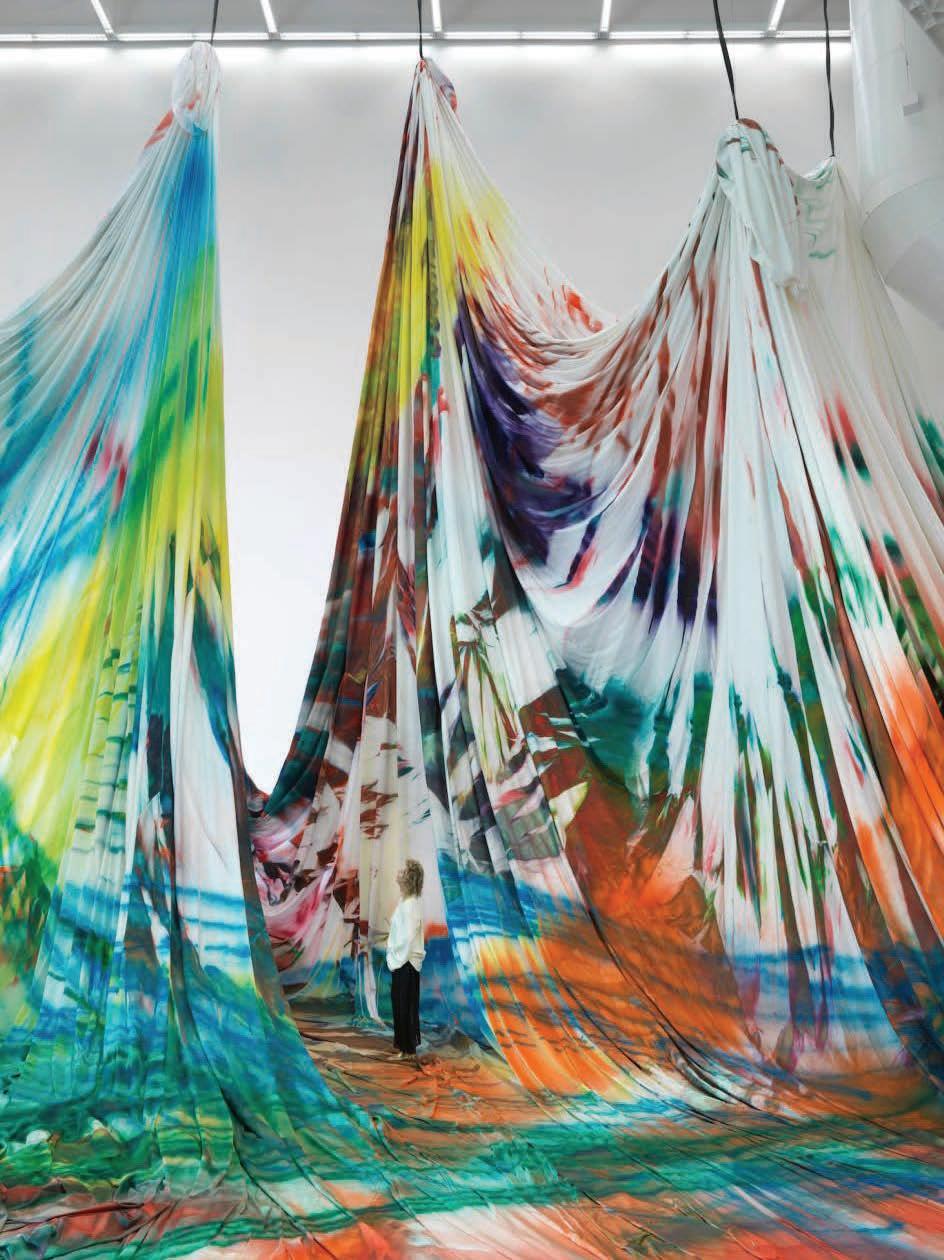
With its diverse galleries, pioneering sectors, monumental artworks, and critical engagement with ecology and technology, Art Basel Basel 2025 stakes a powerful claim as a vibrant platform for cultural exchange and artistic innovation.
Reflecting on the edition's significance, Cruse concludes, “The 2025 fair offers an unmatched mix of new voices, innovative formats, and immersive projects— perfectly reflecting the current moment in the global art scene.”
Art Basel Basel 2025 opens June 18, inviting collectors, artists, and audiences worldwide to experience the pulse of contemporary creativity in one of the world’s most storied art capitals.

多様なギャラリー、先鋭的なセクター、巨大なインスタレーション、そし て環境とテクノロジーに対する真摯な姿勢。アート・バーゼル・バーゼル 2025は、まさに「文化的交換と芸術的革新の交差点」としての役割を明 確に打ち出している。
「2025年のエディションは、まさに“今”を映し出す最前線です。新し い声、革新的な形式、没入的なプロジェクトが交差する場になるでしょう」 とクルーゼは語る。
アート・バーゼル・バーゼル2025は、2025年6月18日に開幕。世界 各地のコレクター、アーティスト、観客たちを現代アートの鼓動へと招き 入れる。
で実現した 記念碑的な 文化対話
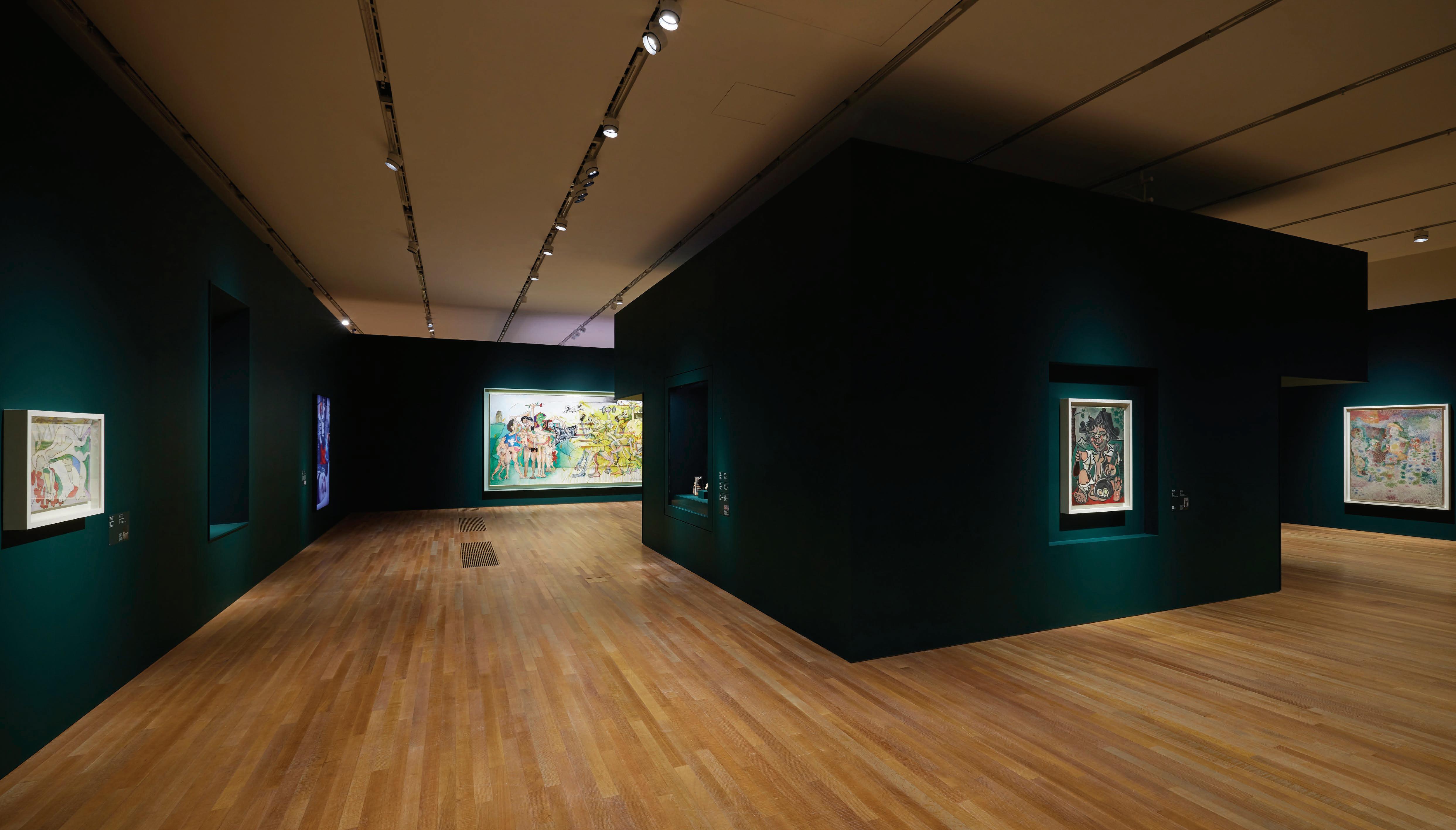
This spring, Hong Kong’s M+ unveiled The Hong Kong Jockey Club Series: Picasso for Asia—A Conversation, a landmark exhibition that reinterprets the towering legacy of Pablo Picasso through a cross-cultural and intergenerational lens. Opened on 15 March 2025, the exhibition marks the first time masterpieces from the Musée national Picasso-Paris (MnPP) have been presented in dialogue with a museum collection in Asia, and the first major presentation of Picasso’s works in Hong Kong in over a decade.
More than sixty of Picasso’s works—including Portrait of a Man (1902–1903), The Acrobat (1930), and Massacre in Korea (1951)—are placed in conversation with around 130 pieces by thirty Asian and Asian-diasporic artists such as Isamu Noguchi, Haegue Yang, and Luis Chan, as well as new commissions by Simon Fujiwara and Sin Wai Kin. Co-curated by Doryun Chong of M+ and François Dareau of MnPP, the exhibition invites viewers to reconsider Picasso not only as a European master but as a global figure whose influence reverberates through contemporary Asian art.
“Asian artists engage with Picasso not just through admiration but through critique, reflection, and reimagination,” noted Chong,
The exhibition presents a cross-cultural and artistic conversation, highlighting Picasso’s enduring influence in contexts far from the places and politics that shaped his work. " "
この春、香港のM+で開幕した 「香港ジョッキークラブシリー ズ:ピカソ──アジアとの対話」 は、美術史におけるピカソの位 置づけを根底から見直す試みと して、世界中の注目を集めてい る。パリ国立ピカソ美術館の貴 重なコレクションが、アジアの 美術館との協働で展示されるの は史上初。2025年3月15日 に幕を開けた本展は、香港で10 年以上ぶりに実現したピカソ大 回顧展でもある。
展示には、《男の肖像(Portrait of a Man)》(1902–03)や《ア クロバット(The Acrobat)》 (1930)、《韓国での虐殺 (Massacre in Korea)》 (1951)といった代表作を含む 60点超の作品が並ぶ。これらの 名作と対話を織りなすのは、イ サム・ノグチ、ヤン・ヘギュ、 ルイス・チャンをはじめとする アジアおよびディアスポラの作 家たち約30名による130点も の作品群。さらに、サイモン・ フジワラやシン・ワイ・キンと いった気鋭のアーティストによ る新作も加わり、時空と文化を 超えた壮大な対話が生まれてい る。本展は、M+のチーフ・キ ュレーターであるドリュン・チ ョン(Doryun Chong)氏と、 MnPPのフランソワ・ダロー (François Dareau)氏が共同 でキュレーションを務めた。
「アジアのアーティストたちは、単なるリスペクトではなく、批評や 再構築という能動的な姿勢でピカソと向き合っている。本展は、ピカ ソを出発点とした文化的対話の場であり、その影響力がいかに世界各 地の文脈へと波及しているかを示すものです」とチョン氏は語る。
The curatorial framework of the exhibition is structured around four archetypes—The Genius, The Outsider, The Magician, and The Apprentice. These thematic chapters guide viewers through Picasso’s multidimensional career while simultaneously inviting reflection through the practices of contemporary artists.
“The Genius” explores Picasso’s myth-making— the way he cultivated the persona of a prodigy and artistic superhuman. Despite his fame, Picasso continued to reinvent himself until his final days, a testament to his restless drive for reinvention. Artists such as Gu Dexin and Tanaami Keiichi respond to this archetype, challenging and reflecting on notions of brilliance and the cult of the artist.
“The Outsider” examines Picasso’s tendency to resist conventions and embrace the marginal—cofounding Cubism, appropriating African motifs, and continually defying artistic norms. The section probes questions of cultural appropriation, highlighting how many Asian artists have also negotiated their own outsider statuses within shifting global contexts.
In “The Magician,” viewers encounter Picasso as the alchemist of everyday life—transforming the mundane into the profound, particularly through his whimsical ceramic works. These are paired with contemporary pieces that similarly elevate the domestic and intimate, pointing to art’s power to enchant.
Finally, “The Apprentice” considers Picasso’s lifelong dialogue with art history. He borrowed liberally and reinterpreted genres, constantly seeking to surpass his influences. This section finds kinship in the works of artists who engage history not with reverence, but as raw material for reinvention.
“We sought to decentre the traditional Western narrative,” noted Cécile Debray, President of MnPP. “This exhibition offers a circular look at Picasso’s legacy from a contemporary Asian perspective, proposing a bold new methodology for understanding influence and reception.”

Presented as the opening programme of the French May Arts Festival 2025, Picasso for Asia has been a defining cultural moment in Hong Kong’s art calendar. It also commemorates the 140th anniversary of the Hong Kong Jockey Club, whose Charities Trust is the exhibition’s title sponsor.
The show has drawn not only seasoned collectors and scholars but also families and young creatives, thanks to robust public programming—including free talks, educational tours, and an interactive Family Kit.
On opening day, a public talk featuring Debray and M+ Museum Director Suhanya Raffel delved into how Picasso’s reception continues to evolve across geographies. “This exhibition demonstrates how cross-cultural collaboration can generate new narratives in world art history,” said Raffel. “It exemplifies M+’s mission to promote multifaceted dialogues around modern and contemporary visual culture.”
展覧会は「天才」「アウトサイダー」「魔 術師」「弟子」という4つのテーマに基づ いて構成され、それぞれの章がピカソの芸 術的人格の一側面を照らし出すと同時に、 現代アーティストたちの問いかけを重ね る。
「天才」では、若くして名声を得たピカソ が自らを神話化しつつも、晩年まで自己革 新をやめなかった姿に注目。クー・デーシ ン(Gu Dexin)や田名網敬一らが、その神 格化されたイメージと「天才」信仰に対す る批評的応答を試みる。
「アウトサイダー」は、キュビスムの共同 創始、アフリカ的造形の引用といった、常 に美術の周縁に立ちながら既成の枠組みを 壊してきたピカソを描き出す。この視点は また、グローバルアートの中で自らの位置 を問い続けるアジアの作家たちと重なる。
「魔術師」では、陶芸など日常の素材を変 容させ、魔法のように詩的な世界を立ち上 げたピカソにフォーカス。その創造力は、 家庭的で親密なテーマを扱う現代作家の作 品と共鳴する。
「弟子」は、美術史への飽くなき応答を続 けたピカソの姿を浮き彫りにする。伝統を 解体し、再構築するという姿勢は、歴史を 素材として自在に操る今日のアーティスト たちにも通じている。
パリ国立ピカソ美術館の館長セシル・ドゥ ブレイ氏は、「私たちは、西洋中心の美術 史から意識をずらしたかった。この展覧会 は、ピカソの遺産をアジアの視点で円環的 にとらえる、新たな美術史の読み解き方を 提示しているのです」と語る。
4つの顔で紐解くピカソ 現代の視点から再構築された神話
本展は、2025年の「フレンチ・メイ・ア ート・フェスティバル」のオープニング企 画として開催されると同時に、香港ジョッ キークラブ創立140周年を記念する節目の 催しでもある。展覧会には、美術専門家だ けでなく、若い観客層や家族連れも多く訪 れ、無料のトークイベントや教育プログラ ム、双方向性のファミリー・プログラムな ども充実。世代と立場を超えて、芸術との 出会いの場が広がっている。
開幕当日には、ドゥブレイ館長とM+のス ハニャ・ラフェル館長による公開対談も実 施され、地域によって変容するピカソ受容 のあり方が掘り下げられた。ラフェル館長 は、「この展覧会は、文化間の協働がいか に新たな美術史の語りを生むかを物語って います。M+は、現代ビジュアルカルチャ ーを多面的に捉える対話のプラットフォー ムであり続けたいのです」と語った。
越境する視線 アジアのまなざしが再定義するピカソの遺産
As the art world increasingly embraces plurality and critical reflection, Picasso for Asia stands as a model for future curatorial ventures. By situating a European master within a broader global context, M+ has not only expanded Picasso’s audience but also reframed his legacy for a new generation of viewers—one that is as curious as it is questioning.
かつての巨匠像を揺さぶり、アジア という新たな鏡像の中でピカソを映 し出す本展は、キュレーションの未 来を指し示す重要な一例となってい る。問いを持ち、対話に開かれた観 客に向けて、ピカソの遺産は今、静 かに再起動されている。

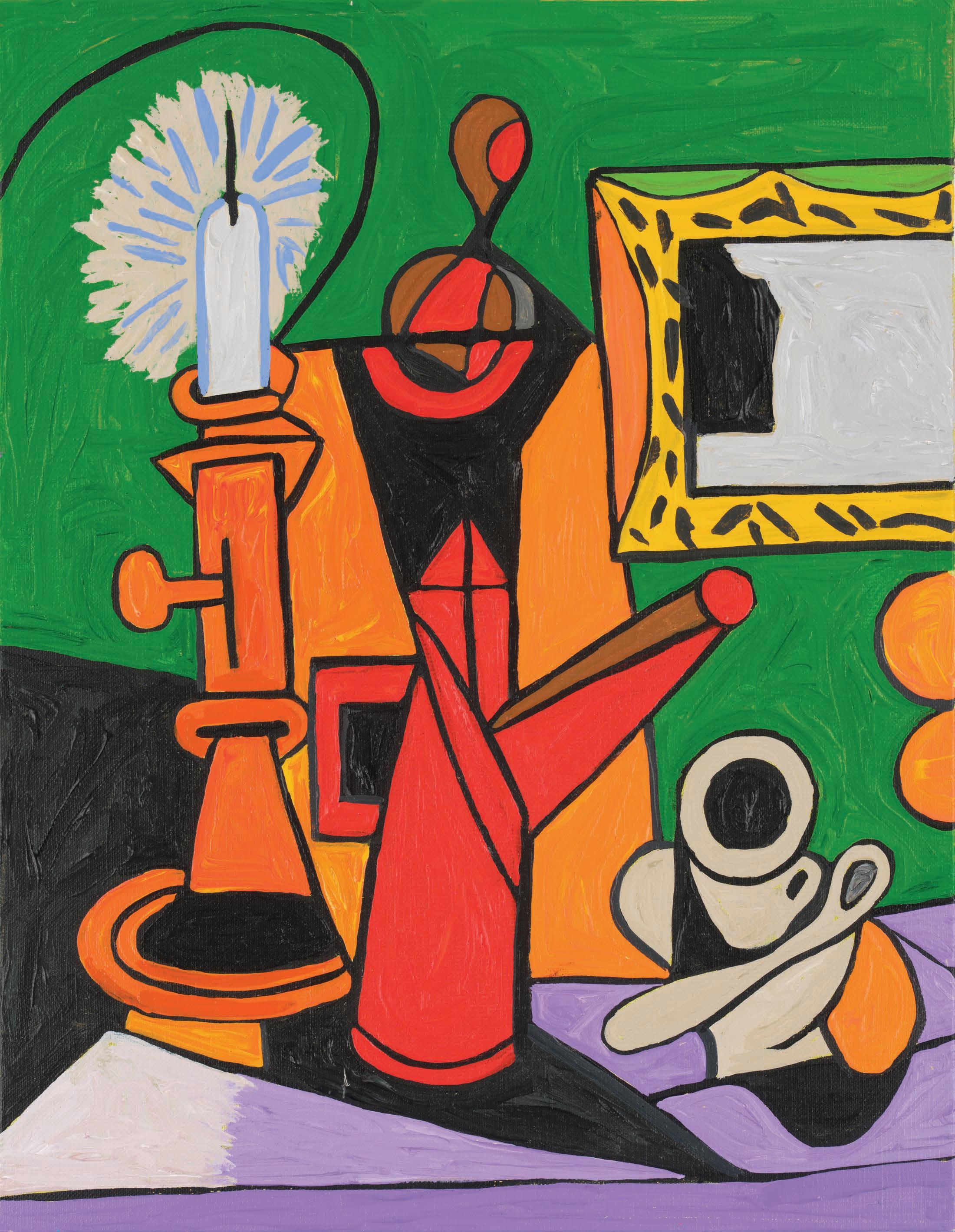

A Journey Through Gaze, A Chronicle of Emotion
In spring 2023, Yoshitomo Nara’s European touring exhibition began with All My Little Words, a solo show at Albertina Modern in Vienna. Centered around nearly four decades of drawings, the exhibition unfolded like a quiet anthology of memory and introspection—intimate, lyrical, and deeply human.
Following its debut in Austria, the exhibition traveled to the Guggenheim Museum Bilbao in Spain and the Museum Frieder Burda in Baden-Baden, Germany. It is now on view at the Hayward Gallery in London, where a greatly expanded iteration titled Yoshitomo Nara offers a comprehensive and immersive experience of the artist’s evolving vision.
This London presentation brings together paintings, drawings, sculptures, and rarely exhibited installations. The exhibition is arranged thematically around ideas such as “memory,” “solitude,” “solidarity,” and “resistance.” Rather than following a chronological order, the works are curated to reflect emotional and conceptual resonance, creating a poetic conversation among them.
A particular highlight is Midnight Tears (2023), a recent work introduced in the latter part of the tour. With its muted palette and haunting expression, the piece encapsulates Nara’s present artistic mood—quiet, introspective, and piercingly vulnerable.
2023年春、奈良美智のヨーロッパ巡回展は、オーストリア・ウィーンの アルベルティーナ・モダン美術館での個展《All My Little Words》を起点 として始まった。およそ40年にわたるドローイング作品を中心に構成さ れたこの展覧会は、彼の創作の原点を静かに紐解くような内容で、観る者 の内面に深く語りかけるものだった。その後、スペイン・ビルバオのグッ ゲンハイム美術館、ドイツ・バーデンバーデンのフリーダー・ブルダ美術 館へと巡回し、現在はイギリス・ロンドンのヘイワード・ギャラリーにて、 さらに展示規模を拡張した《Yoshitomo Nara》展が開催されている。
本展では、奈良の絵画、ドローイング、彫刻、インスタレーションが一堂 に会し、「記憶」「孤独」「連帯」「反抗」などのテーマに沿って構成さ れている。作品は年代順ではなく、感情の流れに従って配置されており、 各作品が空間のなかで詩的な共鳴を生み出している。
なかでも2023年制作の《Midnight Tears》は、巡回後期に初公開された 最新作であり、その沈んだ眼差しと静謐な色彩が観る者の心に深く残る。 本作はまさに、奈良の「今」を象徴する重要作のひとつである。

Music has always been central to Nara’s creative practice. As a child, he listened to the Far East Network (FEN), a U.S. military radio station in Japan, absorbing protest folk, blues, and antiwar ballads that continue to inform his sense of empathy and resistance. Later influences—punk and new wave—further shaped the raw emotional tone of his visual language.
The presence of music is palpable throughout the exhibition. Each work seems to carry rhythm, echo, and refrain—as though it belongs to a larger, silent mixtape. Even in the absence of sound, the viewer can “hear” the compositions resonating on a personal level.
The 2011 Great East Japan Earthquake and the Fukushima nuclear disaster marked a profound shift in Nara’s work. In response, his art became more contemplative, marked by quietness, restraint, and emotional healing.
One of the most poignant examples is From the Bomb Shelter (2017), in which a child cautiously emerges from underground. The piece captures a fragile tension—between fear and hope, isolation and reconnection— without a single word being spoken.
While Nara’s work may appear accessible at first glance, it contains an intense psychological tension. It moves seamlessly between contemporary art and pop culture, engaging universal emotions such as loneliness, anxiety, and quiet defiance.
奈良美智の創作において、音楽は常に核 心にある存在だ。幼少期に聴いたFEN (Far East Network)の反戦フォーク やブルース、青年期以降のパンクやニュ ーウェーブなど、彼の作品には一貫して “音楽の魂”が流れている。
本展では、作品のリズムや構図、空間配 置からもその影響が感じ取れる。まるで 一枚一枚の絵が「聴こえてくる」ような 体験は、音楽と視覚表現を融合させた奈 良独自の美学を如実に示している。
2011年の東日本大震災および福島第一 原発事故は、奈良にとって大きな転機と なった。作風はより内省的になり、喪失 や沈黙、そして再生の可能性をテーマと した作品が増えていく。
《From the Bomb Shelter》(2017 年)は、そうした変化を象徴する作品だ。 地下壕から慎重に顔を出す子どもの姿に は、災厄後の不安と希望が同居し、声を 発さずに語るという奈良の現在の表現が 凝縮されている。
ヘイワード・ギャラリー館長のラルフ・ ルゴフは次のように語る。
「奈良の作品は、親しみやす く見える一方で、非常に高い 心理的緊張を孕んでいます。
現代美術とポップカルチャー の間を縫うようにして、孤独 や不安、静かな抵抗といった 普遍的な感情に訴えかけてく るのです。」


Curated by Yung Ma, with assistant curators Katie Guggenheim and Charlotte dos Santos, the exhibition is accompanied by a beautifully designed catalogue from Praline. The publication features newly commissioned essays by Yeewon Koon, Barry Schwabsky, and Josh Kun, along with an intimate interview between Nara and Ma.
For longtime followers of Nara’s work, the faces he draws may feel familiar. But each time we meet their gaze again, we find ourselves reflecting—perhaps more honestly—on our own inner world. This London exhibition is not a retrospective in the conventional sense. It is an ongoing emotional record—an open-ended gesture from an artist who continues to paint feelings with clarity and quiet strength in a rapidly changing world.

Located in Yokohama’s futuristic Minato Mirai 21 district, the Yokohama Museum of Art was established in 1989, designed by Japan’s renowned architect Kenzo Tange. After a three-year closure beginning in 2021, the museum reopened its doors on March 15, 2024, coinciding with the opening of the 8th Yokohama Triennale. Full operations across the entire museum will resume in 2025, marking a rebirth as a more open and accessible space for the public.
“The Yokohama Museum of Art should not be just a place to view art—it should be a place where people can spend time freely and engage in dialogue with art.”
So says Mika Kuraya, who took on the role of director in 2020. During the recent renovation, the museum’s Grand Gallery entrance hall underwent major refurbishment, including the restoration of its glass roof to allow natural light to pour in. New chairs and tables were also added, creating a comfortable space where visitors can relax, interact, and connect beyond simply viewing artworks.
蔵屋美香館長が語る 横浜美術館 の歴史と未来をつなぐアートの拠点
横浜の新都心、みなとみらい21地区に位置する横浜美 術館は、1989年に日本を代表する建築家・丹下健三の 設計により誕生しました。2021年から約3年間の休 館を経て、2024年3月15 日に「第8回横浜トリエ ンナーレ」開幕とともにリニューアルオープン。2025 年から全館での活動を再開し、より市民に開かれた空 間へと生まれ変わりました。
「横浜美術館は単なる展示施設ではなく、人々が自由 に過ごし、アートと対話できる場で あるべきです」。
そう語るのは、2020年に館長に就任した蔵屋美香氏 です。今回の改修では、エントランスホール「グラン ドギャラリー」を中心に再整備が行われ、自然光を取 り込むガラス屋根が修復されました。また、訪問者が くつろげる椅子やテーブルを新設し、美術鑑賞にとど まらない自由な交流の場が生み出されました。
A key focus of the renovation was to strengthen the museum’s role as an “open plaza.” Kenzo Tange originally envisioned the museum not only as a venue for viewing art but also as a gathering place for conversation and free interaction. However, this potential had not been fully realized until now.
“Inside the museum, we have large rest areas that are bigger than the exhibition rooms—this was part of Tange’s original design. But before the closure, these spaces weren’t being used to their fullest. The plaza in front of the museum is already a special place for the people of Yokohama— children play there, and people spend time in their own ways. We wanted the inside of the museum to be just as free and open.”
今回の改修で特に重視されたのは、美術館が「開か れた広場」として機能することでした。横浜美術館 を設計した丹下健三は、美術館を単なる鑑賞の場で はなく、人々が集い、語らい、自由に過ごせる空間 として構想しました。しかし、これまではその特徴 が十分に活かされていなかったと言います。
「館内には展示室よりも広い休憩スペースがたくさ んあります。これは丹下の設計意図によるもので す。しかし休館前は十分に活用されて いませんでし た。美術館の前に広がる広場は、横浜の人々にとっ て特別な場所です。子供たちが遊び、いろんな人が 思い思いに過ごすこの空間と同じように、美術館の 内部ももっと自由で開かれた場になるべきだと考え ました」。
Yokohama was one of the first cities in Japan to open its port and engage with Western culture. How can a museum reflect this unique history and culture? For Director Kuraya, this has been a major theme.
“Yokohama is a city where different cultures have met and given birth to new values. With this reopening, we’ve organized an exhibition that reinterprets the history of Yokohama from an artistic perspective.”
Currently, to celebrate the museum’s reopening, a special exhibition titled Welcome Back, Yokohama is being held. The exhibition aims to rediscover the story of Yokohama—from before the port opened to the present day—through a diverse range of artworks, including paintings, ceramics, photographs, and video pieces. Divided into eight chapters, the exhibition explores a broad scope: the city before the port opened, the blending of
横浜という都市と美術館のつながり

Western and Japanese cultures, and post-war reconstruction.
“By revisiting Yokohama’s complex history through the lens of art, we hope people can come to understand their city from a new perspective,” says Kuraya. Highlights include ceramics that symbolize cross-cultural exchange during the port’s early days, as well as contemporary art that reinterprets Yokohama’s history.
“For instance, we’re displaying historical photographs depicting attacks on foreigners in the late Edo period alongside export ceramics made in Yokohama for the European market shortly after. By placing these seemingly contradictory elements—exclusion and exchange—side by side, we hope visitors will feel the complexity of Yokohama’s history.”
横浜は、日本で最も早く開 港し、西洋文化と接点を持 った都市です。この街の歴 史と文化をどのように美術 館として表現するか。それ は蔵屋館長にとって大きな テーマでした。
「横浜は、異なる文化と文 化が交わり、新たな価値を 生み出してきた街です。今 回のリニューアルを機に、 横浜の歴史をアートの視点 から再解釈する展覧会を企 画しました」。
現在、リニューアルオープン を記念し、「おかえり、ヨ コハマ」と題した特別展が 開催されています。本展は、 開港前から現代に至るまで の横浜の歩みを、絵画・陶 磁器・写真・映像など多様 なアートを通じて再発見す ることを目的としています。 展覧会は8つの章で構成さ れ、開港以前の横浜の姿、 西洋と日本の文化が交錯す る歴史、戦後の復興まで幅 広く紹介しています。
「横浜の複雑な歴史をアー トの視点から捉え直すこと で、多くの人に自分たちの 街を新たな角 度から理解し てほしいのです」と蔵屋館 長は語ります。特に目を引 くのは、開港期の異文化交 流を象徴する陶磁器や、横 浜の歴史を再解釈した現代 アートの展示です。
「例えば、幕末に起こった 外国人襲撃事件に関する当 時の写真作品と、少し後に 横浜で作られたヨーロッパ 向けの輸出用陶器を並べて 展示しています。排除と交 流、一見対照的な二つの事 象を並列することで、横浜 という街の歴史の複雑さを 感じ取ってもらえればと思 っています」。

Another defining feature of the Yokohama Museum of Art is its strong focus on children’s programs.
“Yokohama is a city with many children. That’s why we want this museum to be a place where kids can naturally encounter art and have opportunities to learn at any time.”
The museum houses one of Japan’s largest Children’s Studios, where kids can engage handson with a wide range of materials to create their own works. These creative experiences are complemented by programs that guide children to view exhibitions with a deeper understanding. What’s more, children can view exhibitions free of charge—reflecting the director’s strong desire to make art more accessible to as many children as possible.
“As economic disparities grow, more children are losing access to art. But experiencing art at a museum might broaden their future possibilities. I believe one of the museum’s roles is to provide that opportunity.”
“Art may not be able to directly solve social problems. But it can move people’s hearts and shift their way of thinking.”
Director Kuraya says she became more aware of the power of art after the 2011 Great East Japan Earthquake.
“After the disaster, many people tried to use art to change society. It’s true that art can’t directly rebuild an economy, but it can connect people and spark dialogue.”
Museums, she says, are places where people can encounter diverse values and learn to accept different perspectives.

横浜美術館のもう一つの大きな特徴は、 子供のための活動に力を入れていること です。
「横浜は子供が多い街です。だからこそ、 子供たちが自然にアートに触れ、いつで も学べる場所でありたいと思っていま す」。
横浜美術館には、日本最大級の「子ども のアトリエ」があり、子供たちが様々な 素材を使って実際にものをつくることが できます。つくるだけでなく、つくった
市民と共に育つ美術館へ これからの横浜美術館 アートが持つ社会的な力
“Right now, a lack of dialogue is a problem around the world. But if we can use art to cultivate the ability to listen to others with an open mind, maybe the world can become just a little bit better.” リニューアルオープンを経て、新たなスタ ートを切った横浜美術館。蔵屋館長は、今 後もより開かれた美術館を目指していきま す。
With its renewal complete, the Yokohama Museum of Art has embarked on a new chapter. Director Kuraya is committed to building a more open museum moving forward.
“A museum isn’t just a place to look at art. It’s a place where people meet, converse, gain new perspectives, and find the strength to live. I want the Yokohama Museum of Art to continue being a place where people discover something meaningful or feel glad simply to be alive today. That’s the challenge we’ll keep pursuing.”
As a place that connects with citizens through art, the Yokohama Museum of Art will continue to evolve. Expectations are high for what lies ahead.
「美術館は、アートを鑑賞するだけの場所 ではありません。人々が出会い、対話し、 新しい視点を得、生きる力を得るための場 所です。横浜美術館が、何かしらの気づき を得たり、今日一日生きていてよかったと 感じたりしてもらえる場であり続けられる よう、これからも挑戦を続けていきたいで す」。
横浜美術館は、アートを通じて市民とつな がる場所として、これからも発展していき ます。その今後の活動に、ますます期待が 高まります。
体験を元に、展覧会場で作品を鑑賞する プログラムも充実しています。子供たち は、無料で展覧会を鑑賞することができ ます。ここにも、一人でも多くの子供た ちにアートに親しんでほしいとの館長の 思いが反映されています。
「経済格差が広がる中で、アートに触れ る機会が少ない子供たちも増えています。 しかし、美術館でアートを体験すること で、彼らの将来の選択肢が広がるかもし れません。そのきっかけを作るのが、美 術館の役割の一つだと考えています」。
「アートは社会問題を直接解決す ることはできません。でも、人々 の心を動かし、考え方を変えるこ とはできます」。
蔵屋館長は、2011年の東日本大 震災をきっかけに、アートの持つ 力を再認識したといいます。
「震災直後、多くの人がアートを 通じて社会を変えようとしまし た。しかし、経済を直接的に立て 直すことは難しい。でも、アート には人と人をつなげ、対話を生み 出す力があり ます」。
美術館は、多様な価値観に触れ、 異なる視点を受け入れる場でもあ ります。
「今、世界中で対話の欠如が問題 になっています。しかし、アート を通じて人々が柔軟に他者の意見 を聞き入れる気持ちを育むことが できれば、世界は少しだけ良くな るかもしれません」。

空間を編む、世界をまたぐ名和晃平2025年初夏、スイス・ジュネーヴ大劇場で 上演されたパフォーマンス作品《Mirage》 を起点に、私たちは彫刻家・名和晃平に話を 聞いた。 公演開始を目前に控えたある日、 劇場の静かな一角で、名和は短時間ながらも 貴重なインタビューの時間を快く引き受けて くれた。翌日にはすでに次の現場へ移動する 予定があるという多忙のなかであったが、ひ とつひとつの問いに、落ち着いた口調で丁寧 に応じてくれた。
現在、名和は東京で開催中の個展 「Sentient」、2025年関西万博における空 間設計、そして京都・Sandwichスタジオに おける継続的な創作と教育など、複数の領域 で同時並行的に活動を展開している。私たち はその動きの渦中にある名和に、近年の作品 制作における関心──「構造」「身体」「知 覚」──について、あらためて話を聞いた。
In early summer 2025, we sat down with sculptor Kohei Nawa in Geneva, just ahead of the premiere of his new performance work Mirage at the Grand Théâtre de Genève. Despite a tightly packed schedule—he was set to depart for his next project the following day—Nawa generously made time for a short but invaluable conversation. Calm and focused, he thoughtfully responded to each question.
At present, Nawa is simultaneously engaged in multiple projects: his solo exhibition Sentient in Tokyo, the spatial design for the Expo 2025 Osaka, Kansai, and ongoing artistic and educational activities at his Kyoto-based studio, Sandwich. We spoke to him amid this dynamic moment about the key themes shaping his recent work—structure, the body, and perception.
A Stage Where Body and Structure Intersect 身体と構造が交差する、もうひとつの舞台
Mirage is a performance that unfolds through abstract composition, devoid of narrative or language, transforming the space itself. Building on the experimental groundwork of Mirage [transitory] which was performed at THEATER 010 in Fukuoka, this new full-scale version in Geneva featured 16 dancers and a highly developed scenographic environment.
“This piece has finally come to life as a full theatrical production,” Nawa explained. “It began in a small theatre where dancers appeared right before the audience, creating an intense and intimate experience. We expanded that world and scaled it up significantly for this Geneva premiere.”
Nawa approaches the stage not as a fixed “structure,” but as a generative sculpture—a spatial composition that emerges and
《Mirage》は、表面的な物語や言語を排した抽象的構成に よって、空間そのものが変化していく作品である。福岡の THEATER 010 で上演された Mirage [transitory] の実験的成果 を基盤に、ジュネーヴでの本作では、16名のダンサーとと もに本格的な舞台美術が組み上げられた。
「この作品は、ようやく劇場バージョンとして公開できまし た。最初にミニシアターで目の前にダンサーが現れる迫力の あるパフォーマンスが生まれ、その世界観を発展させ、スケ ールを一気に上げてジュネーヴの本格公演につながったんで す。」
名和は舞台を「構造物」ではなく、「生成される『彫刻』」
evolves. Elements such as light, water, mist, bodily movement, and sound converge through the viewer’s perception to form a living landscape.
“I propose sculptural elements like landscape-like structures and materials that interact directly with the body,” he said. “Damien [Jalet, choreographer] then creates the choreography in response. The ideal is for body and space to exist in mutual resonance.”
For Nawa, theatrical space is not merely a container but a field of perception and memory, constantly in flux as the audience’s gaze shifts. At the intersection of sculptural notions of time and space and the linear temporality of live performance, Nawa finds a fertile ground for creating new forms of experience.
としてとらえている。光、水、霧、身体の動き、音響──そ れらが観客の知覚を通じて、ひとつの風景として立ち上がる。
「ランドスケープのような構造や身体が直接関わる素材を私 が提案し、それに対してダミアンが振付を行う。身体と空間 が呼応し合うことが理想です。」
舞台における空間とは、単なる物理的な容器ではなく、感覚 と記憶が交錯する「場」である。観客の眼差しは常に揺らぎ、 そのなかで作品は流動し続ける。彫刻家としての時空間の概 念と、舞台という線的時間の交差──その接点に、名和の思 考する「場」がある。
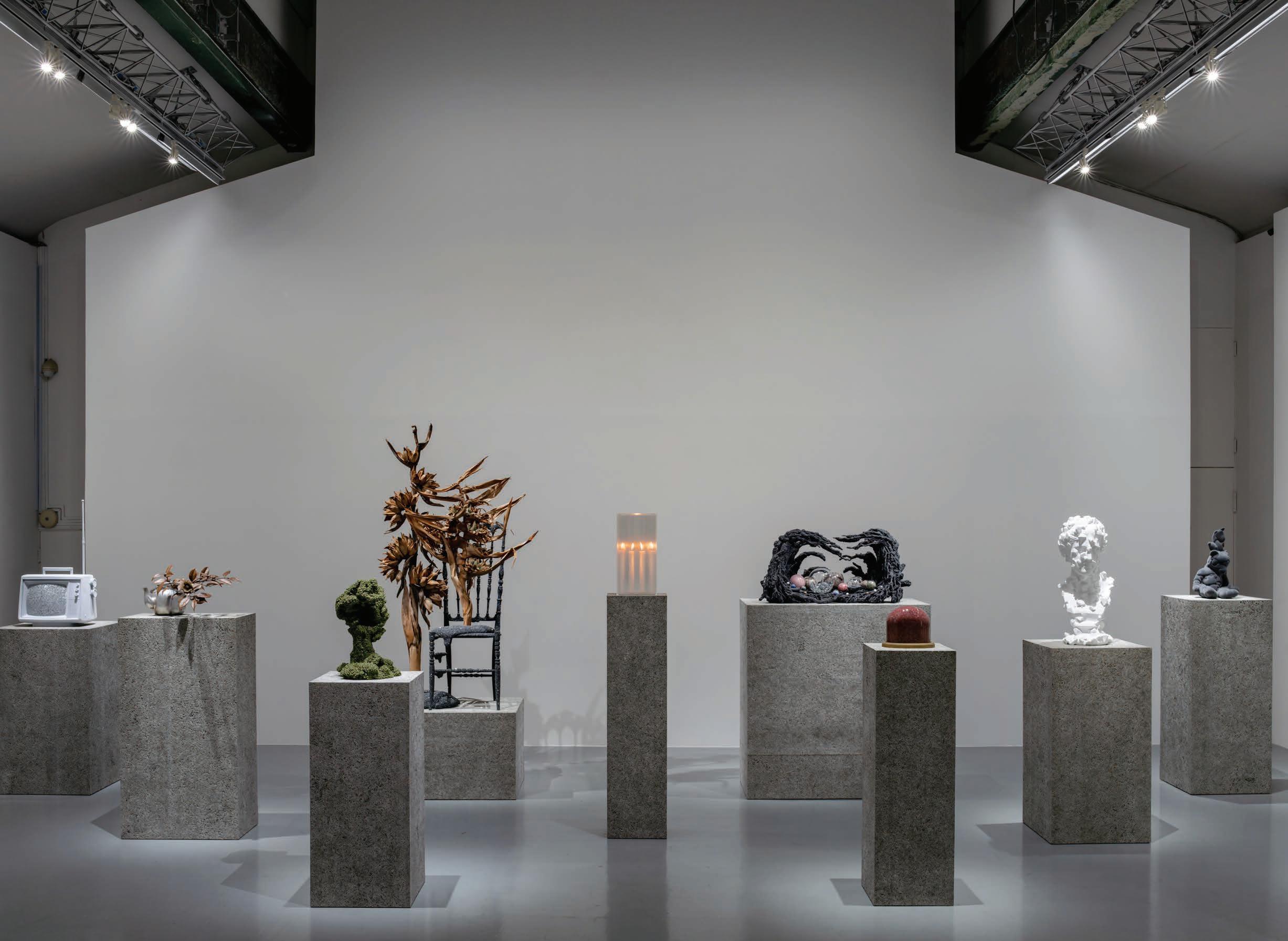

感覚される造形、静けさの知覚
Running concurrently in Tokyo at SCAI THE BATHHOUSE, Nawa’s solo exhibition Sentient explores the perception of light and material. It represents a further development of his Material and Book Shelf series, which began with the 2023 exhibition From Code to Material at kojin kyoto. These works, though physically static, change continuously in response to the viewer’s gaze and breathing.
“This show is structured differently from my previous exhibitions. It’s an experimental format that brings together multiple series in a single space,” Nawa explained. “At SCAI, I’m always encouraged to take new creative risks.”
Combining natural materials, minerals, resins, and diverse techniques, the exhibition features no fixed path; viewers are free to navigate the space, forming direct, personal encounters with each work.
“In a gallery setting, visitors can move at their own pace. What I try to create is the moment where, within that freedom, the senses open and thought deepens.” In this context, “seeing” becomes something more than the acquisition of information—it is a pre-linguistic, sensorial experience, woven from the interplay of material, light, and shadow.
東京・SCAI THE BATHHOUSEで同時期に開催中 の個展《Sentient》 では、光や物質の知覚に焦点 を当てたインスタレーションが展開されている。 これは、2023年にkojin kyotoで開催された個展 「From Code to Material」から継続的に取り組ん でいる「Material and Book Shelf」シリーズの深 化でもあり、作品は静的な造形物であると同時に、 鑑賞者の視線と呼吸によって常に変化する。
「本展は今までの展示とは異なり、さまざまな作品 シリーズを一つの空間内に取り合わせるという実験 的な構成になっています。SCAIでは、常に新しい 挑戦が求められるのです。」
自然物や鉱物、樹脂といった多様なマテリアルと手 法が混在する作品群へ、動線は固定されておらず、 鑑賞者が自由に歩み寄ることによって個々の作品へ 向き合うことができるように構成されている。
「ギャラリーでは、鑑賞者が自分のペースで移動で きる。その自由な時間のなかで、『感覚がひらかれ、 思考が深まっていく瞬間』をどう生み出せるかを大 切にしています。」
この空間における「見ること」は、もはや情報の収 集ではない。そこには、素材と光と影が織りなす、 視覚以前の経験が存在している。
Nawa’s work extends far beyond object-making. At Sandwich, his studio in Fushimi, Kyoto, experimental creation and educational programs for young artists coexist, while public art and architectural interventions are integrated into urban space. For Nawa, sculpture is not simply the act of giving shape to material, but a fundamental inquiry into how new perceptual experiences can be generated.
“At the studio, students and artists are constantly exchanging ideas and experimenting together,” he said.
His current projects include public artworks in Shanghai, Tokyo, and Osaka; participation in group exhibitions; the spatial design for Kyoto Prefecture’s
pavilion at Expo 2025; and the interior design of a new gallery space in Omotesando. Nawa continues to create new “places” within the contemporary city.
“Ideas come to me naturally, but it takes time to give them form. I try to approach each step with care and intention.”
Space and sculpture, body and perception, city and nature—Nawa’s practice is an ongoing exploration that disrupts conventional boundaries and reveals hidden structures. His works are not merely “exhibited” objects, but continuously woven environments—emergent fields that stand before us, inviting a deeper engagement with the world.
都市と教育、そして造形への信念
名和の活動は、単なる作品制作にとどまらない。 京都・伏見のスタジオ「Sandwich」では、若手 作家の実験的な創作と教育プログラムが交差し、 都市空間におけるアートやその空間の設計提案ま で展開されている。造形とは、単に物にかたちを 与える技術ではなく、「どのように新しい感覚を 生成するか」という問いでもある。
「スタジオでは、学生や作家が行き交いながら、 試作や実験を繰り返しています。」
現在進行中のプロジェクトには、上海や東京、大 阪でのパブリックアート、大阪のグループ展、関 西万博・関西パビリオンの京都府ブースの空間デ

生成ということ
ザイン、表参道のギャラリースペースの設計など も含まれており、名和は都市のなかに新しい「場」 をつくり続けている。
「アイデアは自然に湧いてきますが、それをかた ちにするには時間が必要。一つひとつを丁寧に進 めていくことを心がけています。」
空間と造形、身体と知覚、都市と自然。 名和の創 作は、それらの境界を攪拌し、見えない構造を可 視化する営みである。 作品はただ「展示されるも の」ではなく、絶えず編まれ続ける「場」として、 私たちの前に立ち上がっていく。
In a world increasingly shaped by fleeting trends and digital flux, the Fondation Chu Teh-Chun continues to root its mission in something enduring—art as a bridge between cultures, generations, and perception itself. This spring and early summer, the Geneva-based foundation demonstrated that vision through two remarkable exhibitions that connected the poetic abstraction of Chu TehChun with broader currents in contemporary art and education.
At the heart of this year’s program was a collaborative exhibition with the International School of Geneva (Ecolint), which took place from May 15 to June 27, 2025, at the school’s Centre des Arts. The exhibition focused on a rarely spotlighted facet of Chu TehChun’s oeuvre: his expressive works on paper. These ink and brush compositions, infused with gestural elegance and philosophical introspection, reflected the artist’s deep connection to both Chinese calligraphy and lyrical abstraction. In contrast to his grand canvases, these smaller-scale pieces offered a meditative encounter with line, emptiness, and movement— core elements of his artistic language.
The exhibition was not merely a retrospective, but a layered dialogue between past and present. Since its founding in 2017 by the artist’s family, the Fondation Chu Teh-Chun has prioritized educational outreach and intercultural
engagement. Its partnership with Ecolint—the world’s oldest international school— embodied that ethos, showing how artistic heritage can become a living tool for inquiry, empathy, and selfdiscovery.
Running concurrently was the Chu Teh-Chun Prize exhibition, which featured artworks by 11th-grade Ecolint students. Now in its third edition, the prize invited young artists to explore their creative voices through introspection and experimentation. The student show opened on May 22, and the award ceremony was held on June 17. A panel of educators, foundation members, and guest artist Dr. Momar Seck selected the winner, who received an international residency opportunity designed to foster further artistic growth.
On the international stage, the Fondation continues to make its presence felt at Villa Carmignac on Porquerolles Island, where it is currently participating in the major group exhibition VERTIGO, running from April 26 to November 2, 2025. Curated by Matthieu Poirier, the show explores the sensory disorientation that arises at the intersection of nature and abstraction, presenting post1950 artworks that respond to elemental forces—water, sky, earth, light. Chu Teh-Chun’s works appear alongside those of Olafur Eliasson, Helen Frankenthaler, Gerhard Richter, and Yves Klein, placing his poetic approach within a rich constellation of visionary creators.


On the international stage, the Fondation continues to make its presence felt at Villa Carmignac on Porquerolles Island, where it is currently participating in the major group exhibition VERTIGO, running from April 26 to November 2, 2025. Curated by Matthieu Poirier, the show explores the sensory disorientation that arises at the intersection of nature and abstraction, presenting post-1950 artworks that respond to elemental forces—water, sky, earth, light. Chu Teh-Chun’s works appear alongside those of Olafur Eliasson, Helen Frankenthaler, Gerhard Richter, and Yves Klein, placing his poetic approach within a rich constellation of visionary creators.
The inclusion of Chu’s work in VERTIGO is particularly resonant. His art has long engaged in a vertiginous dialogue with nature— not through direct depiction, but through rhythm, luminosity, and the evocation of the invisible. In the immersive setting of Villa Carmignac, where architecture and landscape blend seamlessly, his work finds a perfect echo.
As a cultural actor, the Fondation Chu Teh-Chun continues to evolve. It is not a static guardian of legacy, but a dynamic platform that embraces publication, education, and international collaboration. Its catalogue raisonné grows in tandem with its partnerships, its archive lives not in isolation, but in dialogue with audiences around the world.
In Geneva, students rediscovered how to see. In Porquerolles, visitors continue to experience the awe of elemental form. And at the center of it all stands the Fondation—a living reminder that art, at its best, does not stand still. It moves us forward.
そして今、財団の活動は、地中海に浮かぶポルクロール島のヴィ ラ・カルミニャックへと舞台を広げている。現在、同地で開催中 の国際的なグループ展「VERTIGO」(会期:2025年4月26日 ~ 11月2日)に参加しており、本展はキュレーターのマチュー ・ポワリエ氏によって企画され、自然と抽象表現が交差する瞬間 に生じる感覚の揺らぎ──すなわち「めまい」──を主題として いる。水、空、光、大地といった自然の根源的な力に呼応する、 1950年以降の作品群が空間に共鳴しあう中、チュー・テチュン の作品もまた、オラファー・エリアソン、ヘレン・フランケンサ ーラー、ゲルハルト・リヒター、イヴ・クラインといった巨匠た ちの作品とともに展示されている。そこでは、時代や形式を超え たヴィジョンが、ひとつの空間に交差している。
この展覧会において、テチュンの作品が描き出す「自然とのめま いの対話」は、とりわけ深い印象を残す。彼は自然を写し取るの ではなく、光の余韻、流動するリズム、そして目に見えぬ気配を 通して、その本質に迫ろうとしてきた。建築と自然が滑らかに融 合するヴィラ・カルミニャックの空間において、彼の作品は風景 そのものの一部となり、静かに、しかし確かに息づいている。
フォンダシオン チュー・テチュンは、過去を守るだけの番人では ない。出版、教育、そして国際的な協働といった多様なアプロー チを取り入れながら、時代とともに呼吸し続ける、しなやかな創 造のプラットフォームである。進化し続けるカタログ・レゾネと ともに、そのアーカイブは今も世界各地の鑑賞者と呼応し、対話 を紡ぎ続けている。
ジュネーヴでは、学生たちが「見る」という行為そのものを、改 めて捉え直していた。ポルクロールでは、訪れる人々が、風と光 の中に揺らめく「かたちにならない自然」に、静かに息をのんで いる。そして、その両者の中心にあるのが、チュー・テチュンの 名を冠したこの財団である。芸術は決して立ち止まらない。それ は、声を荒らげることなく、しかし確かな力で、私たちを未来へ と導いてゆく。
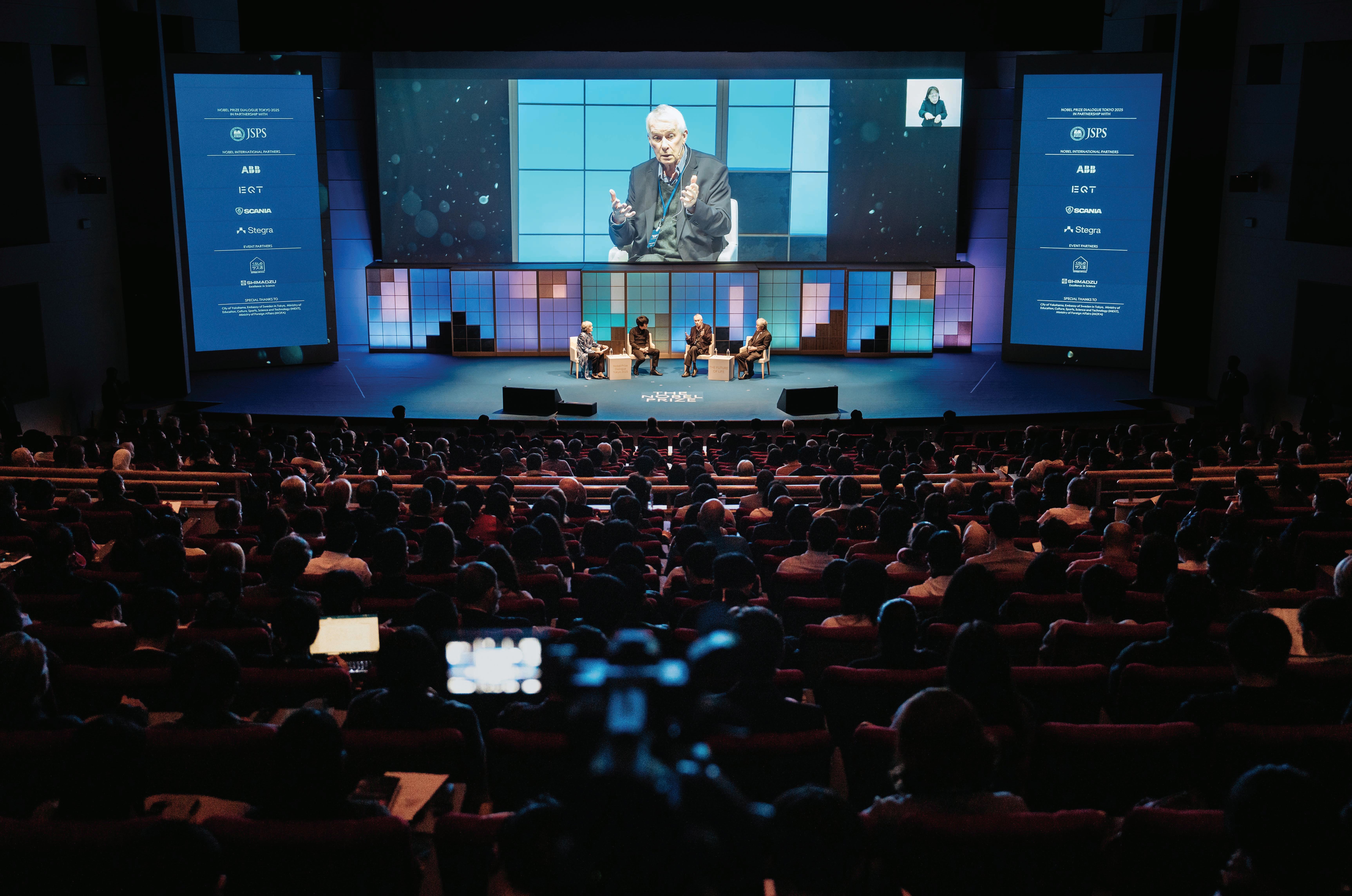
In an era where technology is evolving at an accelerating pace and the future is becoming increasingly unpredictable, how should we think about what lies ahead?
To explore that question, the Nobel Prize Dialogue Tokyo 2025 was held in March 2025.
This international dialogue forum is cohosted by The Nobel Prize Outreach organisations and the Japan Society for the Promotion of Science (JSPS). Nobel Laureates and leading researchers from around the world gathered in Tokyo to engage in in-depth discussions on the impact of science on society.
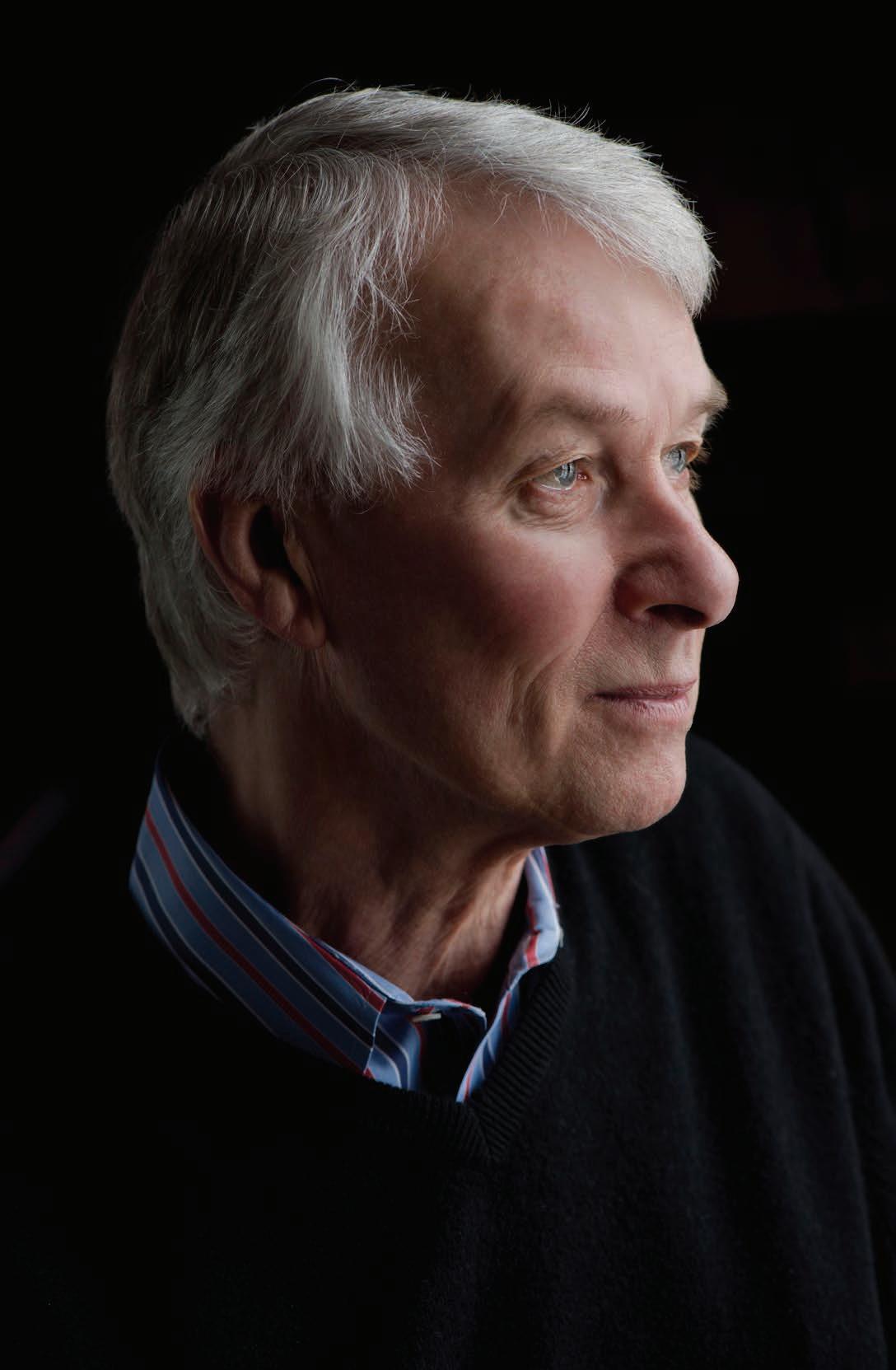
One of the most compelling voices at the event was that of Richard Roberts, recipient of the Nobel Prize in Physiology or Medicine. From the outset, he emphasized that science is about “the power to ask questions”— a fundamental ability that defines what it means to be human.
“AI has certainly advanced. But can it independently ask fundamental questions like, ‘Why is the nose shaped this way?’ That’s where human creativity lies,” he said.
He also spoke about the rapid progress in CRISPR geneediting technology, predicting that “in the near future, it will become normal to treat genetic disorders at the fetal stage.” At the same time, he cautioned that “ethical issues surrounding who uses this technology and who benefits from it make dialogue between science and society indispensable.”
Roberts also sharply addressed social misconceptions about GMOs (Genetically Modified Organisms), stating, “There hasn’t been a single accident in over 30 years of use. Yet opposition movements persist—not because of science, but due to politics and money.” He went so far as to describe opposition to Golden Rice, a genetically modified crop designed to combat vitamin A deficiency, as “a crime against humanity.”
In a separate interview, when asked about the future of science, Roberts said, “Compared to 30 years ago, advances in DNA analysis and genome research have been revolutionary. We are entering an era in which we can design life itself.” Addressing the younger generation, he said emphatically, “There is still so much we don’t know in biology—much more room for discovery than in physics. That’s why now is the time to enter this field.”
ノーベル化学賞を受賞し、リチウムイオン電 池の父として知られる吉野彰氏は、講演とイ ンタビューを通して、科学が社会に実装され ていくダイナミズムを語った。
1995年、Windows 95の登場により、電池 需要が爆発的に拡大した時代を「技術が世界 を動かした瞬間」と述懐。製品化してもすぐ には売れず、社会が追いついてくるまで数年 かかる。だがその「時代との接点」にこそ、 研究の価値があるのだという。
そこで、未来に向けた研究の方法論として強 調したのが「バックキャスティング」だ。 「2050年の社会をまず想像し、そこから逆 算して必要な技術を考える。そうすれば、今 どこに立ち、何をすべきかが見えてくる」 と、若い世代へのメッセージを送った。
さらに個別インタビューでは、「科学者とし て最も感動した瞬間は?」という問いに対し て、「社会が自分の研究成果によって大きく 動いたと実感したとき」と語る。その象徴 が、リチウムイオン電池が世界のエネルギー 構造に影響を与えた1995年だったという。
「研究は孤独な時間の連続だが、振り返って みれば、点が線につながる感動がある」と、 温かい眼差しで語ってくれた。
The Power to Create, the Power to Question — Richard Roberts’ Message Technology and Imagination for the Future — Akira Yoshino on the Horizon of 2050
創造する力、問いを立てる力── リチャード・ロバーツの提言
強烈なメッセージで会場を引き込んだのが、ノーベル生理学・医学賞受賞者リチャード・ロ バーツ氏だ。彼は冒頭から、科学とは「問いを立てる力」であり、それこそが人間を人間た らしめる能力だと語った。
「AIは確かに進化した。でも、『なぜ鼻はこういう形なのか』といった根源的な問いを、自 ら立てられるか?そこに、人間の創造性がある」。
さらに彼は、遺伝子編集技術「CRISPR」の飛躍的進展についても触れ、「近い将来、胎児の 段階で遺伝的疾患を治療することが当たり前になるだろう」と語る。一方で「その技術を誰 が使い、誰が利益を得るのかという倫理的課題は、科学と社会の対話が不可欠だ」とも語っ た。
GMO(遺伝子組み換え作物)に対する社会的誤解にも鋭く言及。「30年以上の使用実績の 中で事故は一例もない。それなのに反対運動が続くのは、科学的根拠ではなく、政治と資金 の問題だ」と指摘し、ビタミンA不足を補う「ゴールデンライス」への反対を「人道に対す る罪」とまで断じた。
さらに個別取材の中で、科学の未来について問われたロバーツ氏は、「30年前に比べて、 DNA解析やゲノム研究の進展は革命的。今後は、生命そのものをデザインする時代になる」 と語った。そして、未来を担う若者たちに向けて、「生物学にはまだまだわかっていないこ とが多い。物理学よりも『余白』がある。だからこそ、今この分野に飛び込むべきだ」と、 力強く語っていた。
Akira Yoshino, Nobel Laureate in Chemistry and known as the father of the lithium-ion battery, spoke through his lecture and interview about the dynamism with which science is implemented into society.
Reflecting on the explosion in battery demand triggered by the release of Windows 95 in 1995, he called it “a moment when technology moved the world.” He noted that even after a product is developed, it may take years for society to catch up. Yet, it is precisely in these moments of intersection between research and societal needs that the true value of research emerges.
He emphasized the importance of the backcasting approach for future-oriented research: “Envision the society of 2050 and work backwards to determine what technologies will be needed. That process reveals where we stand today and what we should be doing.”
In a separate interview, when asked what moment moved him most as a scientist, he replied, “It was when felt that society had truly changed because of my research.”
That moment was 1995, when lithium-ion batteries began influencing the global energy structure. “Research is a series of solitary hours, but in retrospect, the dots connect into a line—it’s an emotional journey,” he said with a warm gaze.

Tsuyoshi Sugino
杉野剛氏
The president of the Japan Society for the Promotion of Science (JSPS.
独立行政法人 日本学術振興会(JSPS)の理事長
Photo: Clément Morin. © Nobel Prize Outreach

Many speakers at the event expressed their hopes and expectations for the younger generation.
Following Richard Roberts’ words— “Even if someone tells you it’s impossible, walk the path you believe in”—Ada Yonath stated, “A challenge that seems reckless may have the potential to change the world.”
Ada Yonath, a chemist from Israel, received the Nobel Prize in Chemistry in 2009 for her groundbreaking work in elucidating the structure of ribosomes, the “protein factories” inside cells. At the age of 84, she continues to pursue science and the future with unwavering passion.
William D. Phillips, who won the 1997 Nobel Prize in Physics for his development of methods to cool and trap atoms with laser light, warned: “Young children are bundles of curiosity, but education can extinguish that flame.” He emphasized the need for an educational approach that protects and fosters creativity.
Hiroshi Ishiguro, professor at Osaka University’s Graduate School of Engineering Science and world-renowned roboticist, took the stage alongside his android. He argued that “technology is shaking the very definition of what it means to be human.” In response, Richard Roberts countered, “The ability to creatively ask questions is the essence of humanity.”
“If there is something AI and robots cannot do, it is the ability to continue asking questions,” he asserted words that sounded both like a reflection and a warning for the future.
What emerged from Nobel Prize Dialogue Tokyo 2025 was the realization that scientific progress alone does not build the future. What matters is how science is questioned, how it connects to society—and above all, that these questions are driven not by technology, but by the human will to keep questioning.
As AI and quantum technologies continue to evolve, fundamental questions like “What does it mean to be human?” and “What kind of knowledge is truly needed for the future?” are beginning to carry unprecedented weight.
For science to bring hope to society, we need not only prediction, but also imagination and dialogue.
The Nobel Prize Dialogue Tokyo 2025 remains a vital platform to pursue that vision
若者へ、科学の扉を 開くメッセージ
本イベントでは多くの登壇者が、若い世 代への希望と期待を語った。
「誰かに『それは無理だ』と言われて も、自分の信じた道を進んでほしい」と 語るロバーツ氏に続き、アダ・ヨナット 氏は「無謀に思える挑戦が、世界を変え る可能性を持つ」と語った。
アダ・ヨナット氏は、イスラエル出身の 化学者であり、細胞内の「たんぱく質工 場」とも呼ばれるリボソームの構造を世 界で初めて解明した功績により、2009 年にノーベル化学賞を受賞した人物だ。
84歳の今もなお、科学と未来に情熱を 注ぎ続けている。
また1997年、「レーザー光による原 子の冷却・トラップ法の開発」でノーベ ル物理学賞受賞を受賞したウィリアム・ D・フィリップス氏は「幼い子どもは好 奇心の塊だが、教育によってその火を消 してしまうことがある」とし、「創造性 を守る教育」の必要性を訴えた。
人間とは何か? 科学 とテクノロジーの交差 点で
大阪大学基礎工学研究科教授であり、世 界的なロボット工学者として知られる石 黒浩教授は、自身が開発したアンドロイ ドと登壇。「テクノロジーは人間の定義 そのものを揺るがす」と語る一方、ロバ ーツ氏は「創造的に問いを立てる能力こ そが人間の本質」と反論。
「AIやロボットにできないことがある とすれば、それは『問い続ける力』だ」 と語る姿は、未来への警鐘とも受け取れ た。
問いを恐れず、未来 をひらく
「ノーベル・プライズ・ダイアログ東京 2025」を通じて浮かび上がったのは、 科学の進歩だけでは未来はつくれないと いう事実である。重要なのは、その科学 をどう問い、どう社会と結びつけるか。 そして、それを担うのはテクノロジーで はなく、「問い続ける力」を持つ人間の 意思である。
AIや量子技術が進化を続ける中で、「人 間とは何か」「未来にとって本当に必要 な知とは何か」といった根源的な問い が、かつてない重みを持ち始めている。 科学が社会に希望をもたらすためには、 「予測」だけではなく、「想像」と「対 話」が必要だ。「ノーベル・プライズ・ ダイアログ東京2025」は、そのための 貴重な舞台であり続けている。
The BMW Art Car series, which marks its 50th anniversary this year, has long represented the intersection of art, design, and high-performance engineering. Since its inception in 1975, when Alexander Calder famously transformed a BMW into a moving masterpiece, the series has become a platform for some of the world’s most prominent artists. Figures such as Andy Warhol, Roy Lichtenstein, and Jeff Koons have contributed to the evolution of this remarkable collaboration, which continues to explore the boundaries between creative expression and automotive excellence. As Thomas Girst, BMW’s head of global cultural initiatives, explains, "Creative freedom is essential for our designers and engineers, as well as for the artists we collaborate with". Known for her abstract and dynamic approach to space and movement, Mehretu’s artistic vision aligns perfectly with BMW’s innovative M Hybrid V8 race car. "The car became this whole space of imagination, pushing the limits of what can be possible—a sort of creative lab," Mehretu recalls, reflecting on her journey of merging art and technology. 「BMWアート・カー」コレクション性能と創造性の融合 今年で50周年を迎える「BMWアート・カー」

作品へと変貌させたことに始まります。以来、 このコレクションは、世界的に著名なアーティ ストたちにとって自由な創造の場となり、アン ディ・ウォーホル、ロイ・リキテンスタイン、 ジェフ・クーンズといった巨匠たちが、その進 化に貢献してきました。「BMWアート・カー」 は、芸術と自動車技術の境界を押し広げる実験 的な試みであり、今後もその可能性を探求し続 けていきます。
BMWのグローバル文化プロジェクト責任者で あるトーマス・ギルスト氏は、「創造の自由は、 当社のデザイナーやエンジニアだけでなく、協 力するアーティストにとっても不可欠な要素で す」と語ります。メレトゥ氏は、空間と動きを 抽象的かつダイナミックに描くスタイルで知ら れ、その芸術的ビジョンはBMWの革新的な MハイブリッドV8と見事に響き合います。 「この車は、想像力を解き放ち、可能性の限界 を押し広げる空間となりました。まるで創造の 実験室のような存在です」とメレトゥ氏は振り 返り、アートとテクノロジーが交差する過程を 振り返りました。

For Mehretu, the process of adapting her painting Everywhen to the BMW M Hybrid V8 marked a significant departure from her usual approach to art. Typically working with large canvases, Mehretu embraced the idea of fusing her work with the physicality and speed of a race car. "I asked myself: What would happen if the car simply went through the painting and got affected by it?" she explains, describing her vision of a vehicle that morphs into her painting and vice versa. This concept led to the creation of what she calls a "performative painting"—a car that bears the marks of its own journey on the racetrack.
Mehretu collaborated closely with BMW’s engineers to ensure that her abstract designs interacted dynamically with the car’s movement. "We even changed and added marks of the painting accordingly with the BMW team. Vertical marks disappear in a blur;
メレトゥ氏にとって、自身の絵画 《Everywhen》をBMW Mハイブリ ッドV8に落とし込むプロセスは、こ れまでの制作手法とは大きく異なる挑 戦でした。普段は大規模なキャンバス に向き合う彼女ですが、今回は作品を レースカーのフォルムやスピードと調 和させる試みを行いました。「もし車 がそのまま絵画の中を突き抜け、影響 を受けたとしたら?」という発想から 生まれたのが、車と作品が一体化する というビジョンでした。こうして誕生 したのが「パフォーマティブ・ペイン ティング」という概念です。つまり、 レーストラックを疾走することで、自 らの軌跡を刻む芸術作品としての車な のです。
horizontal marks tend to remain visible," she shares, underscoring how the car’s speed and motion became an integral part of her artistic process.
Mehretu’s experience of watching the BMW M Hybrid V8 race in Daytona further shaped her artistic approach. "It wasn’t until after saw the car race that I had an idea," she recalls. Witnessing the coordinated efforts of the drivers, engineers, and pit crew, Mehretu realized that the car itself was a performance in motion—a machine transformed by the energy of the race. She wanted her artwork to reflect the battles the car would endure during the 24 Hours of Le Mans, with the final marks left not only by her hand but by the race itself. "The final marks would be those left by the drivers getting in and out of the car during the race, and the track itself. That was the performative element," she explains.
メレトゥ氏はBMWのエンジニアたち と密に協力し、彼女の抽象的なデザイ ンが車の動きとダイナミックに相互作 用するよう調整しました。「BMWチ ームと共に、作品に新たなマークを加 えたり変更を加えたりしました。縦の ラインはスピードによってぼやけ、横 のラインは比較的はっきりと残る傾向 がある」と彼女は語ります。こうして、 車の速度や動きそのものが、彼女の芸 術プロセスの一部として組み込まれて いったのです。
さらに、メレトゥ氏はアメリカのデイ トナビーチでBMW Mハイブリッド V8のレースを観戦し、その体験が自 身のアートへのアプローチを大きく変 えるきっかけとなったといいます。「実 際にレースを目にするまでは、作品の 具体的な方向性が明確になっていませ んでした」と彼女は振り返ります。ド ライバー、エンジニア、ピットクルー が一体となり、極限の状況で築き上げ るレースのエネルギーを目の当たりに したことで、彼女はこの車そのものが 動く芸術作品であると確信しました。 メレトゥ氏は、このアートカーが世界 3大レースのひとつであるル・マン24 時間レースを走ることで、単なるビジ ュアル表現を超え、戦いの証を刻み込 む存在となることを望んでいました。 「最終的なマークは、私の手によるも のだけでなく、レースそのものが刻む ものになる。ドライバーが乗り降りす る際に残す痕跡、そしてトラックが車 に与える衝撃。それこそが、私の考え るパフォーマンス・アートの本質なの です」と彼女は語ります。
For over five decades, the BMW Art Car series has played a pivotal role in the company’s cultural engagement, acting as a bridge between automotive design and contemporary art. "The art cars are at the DNA of our cultural engagement and our core business," Thomas Girst explains. "With the BMW Art Cars, the canvas is a BMW, and we are always part of the story". This connection between the car manufacturer and the art world is built on mutual respect for creativity and innovation, allowing artists like Mehretu to push their own boundaries in collaboration with BMW’s cutting-edge technologies.

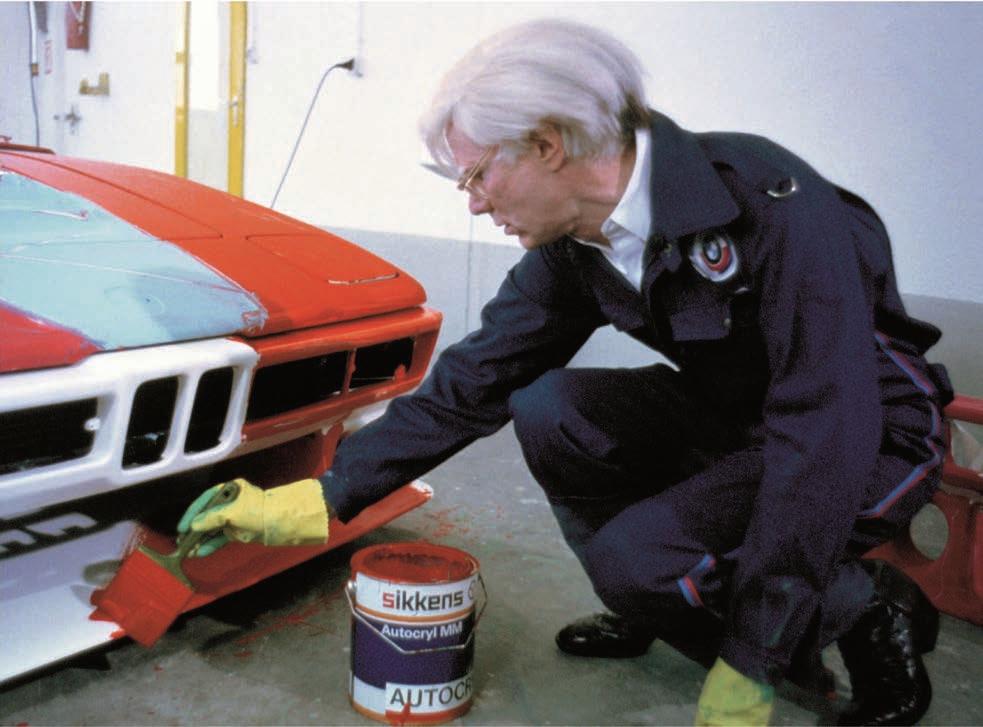


Girst emphasizes that BMW’s cultural initiatives are not just about marketing but stem from a deep-seated passion for both motorsport and art. "I thought there were really basic ways of engaging in the arts... but I changed my mind because I learned the history of the BMW Art Car series," he explains. He points out that the series was born from a genuine love for racing and artistic expression, beginning with Hervé Poulain, who approached BMW’s motorsports director at Le Mans to create the first Art Car with Calder. Today, that same passion drives the ongoing series, which will see the Art Cars embark on a global tour, celebrating their 50th anniversary by traveling to over 30 countries.
The BMW Art Car series has never been about creating static objects but rather about fostering dialogue and creativity. Girst notes that the collaboration with artists allows BMW to stay at the cutting edge of both technology and design. "We consider ourselves not only a car manufacturer or a mobility provider, but also a tech company," he says. "Artists love to talk with our engineers because we have people working in AR, VR, and digital sound that they could never experience in their own studios". This blend of artistic curiosity and technological innovation defines BMW’s unique cultural footprint, which has, over the years, produced some of the most thought-provoking works of contemporary art on wheels.
As the BMW Art Car series embarks on its world tour, it stands as a testament to the power of collaboration, creativity, and pushing the limits of both art and engineering. Mehretu’s contribution, with its emphasis on movement, transformation, and the performative nature of the car, exemplifies how art can transcend traditional boundaries.
As Girst aptly puts it, "The BMW Art Cars are almost like goodwill ambassadors in terms of what is possible," showcasing not just the brand, but what happens when imagination and technology race forward together.
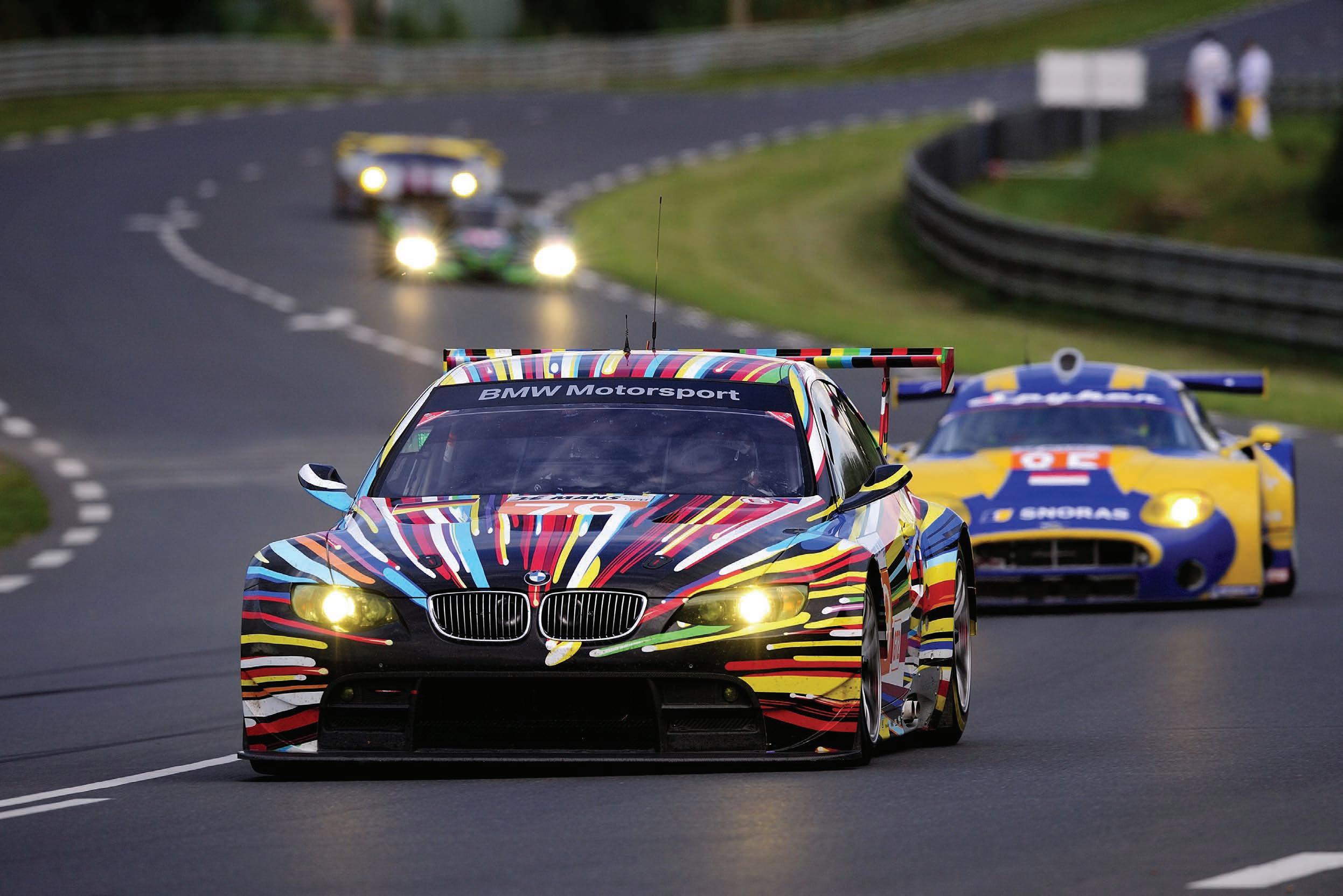
BMWとアート界のつながりは、単なるスポンサーシップではなく、創 造性と革新への深い敬意に基づいて築かれています。メレトゥ氏のよう なアーティストが、BMWの最先端技術と対話しながら新たな表現の可
能性を探求できるのも、その理念があるからこそ実現しているのです。 ギルスト氏は、BMWの文化的活動がマーケティング戦略にとどまらず、 モータースポーツとアートの両方への純粋な情熱から生まれていること を強調します。「当初は、企業がアートに関わる方法には限界があると 思っていました。しかし、BMWアート・カーの歴史を知るにつれ、そ の見方が変わったのです」。このコレクションは、ル・マンで使用する レースカーをアート作品にしたいと考えたフランス人レーシング・ドラ イバー、エルヴェ・プーランがBMWのモータースポーツ・ディレクタ ーに働きかけ、アレクサンダー・カルダーとともに初のアートカーを制 作したことに始まります。
その情熱は50年にわたり受け継がれ、今では「BMWアート・カー」が 世界30か国以上を巡る50周年記念ツアーが予定されています。

「BMWアート・カー」コレクシ ョンは、単なる静的な展示作品を 生み出すことを目的としているの ではなく、対話と創造の場を築く ことに重点を置いています。ギル スト氏はこう語ります。「このコ ラボレーションによって、BMW はテクノロジーとデザインの最前 線に立ち続けることができるので す。私たちは、単なる自動車メー カーではなく、モビリティ・プロ バイダーであり、テクノロジー企 業でもあると考えています。アー ティストたちは、私たちのエンジ ニアと話すのが大好きです。なぜ なら、彼らのスタジオでは体験で きないAR、VR、デジタルサウン ドなどの最先端技術を駆使する専 門家が、ここにはいるからです」。
こうしたアートとテクノロジーの 融合こそが、BMWの文化的なア イデンティティを形作る要素とな っています。「BMWアート・カ ー」コレクションは世界ツアーを 通じて、コラボレーションの力、 創造性、そしてアートとエンジニ アリングの限界を押し広げる精神 を示し続けています。メレトゥ氏 の作品は、動き、変化、そして車 そのものが持つパフォーマンス性 に焦点を当て、アートが伝統的な 枠組みを超える可能性を提示して います。ギルスト氏の言葉を借り れば、「BMWアートカーは、想 像力と技術が共に進化していくこ との象徴として、まるで親善大使 のような存在なのです」。 「BMWアート・カー」コレクションは、50年以上にわたり、自動車デ ザインと現代アートを結びつける文化的プロジェクトとして重要な役割 を果たしてきました。「アートカーは、私たちの文化活動の象徴であり、 BMWのDNAに深く根付いています」とギルスト氏は語ります。「BMW にとって、アート・カーのキャンバスは車そのもの。私たちは常にその ストーリーの一部なのです」。

2025年4月1日から7日にかけて、スイス ・ジュネーブにて開催された「ウォッチズ・ アンド・ワンダーズ ジュネーブ2025」は、 過去最多となる55,000人超の来場者を迎え、 名実ともに世界最高峰の時計イベントとして の地位を改めて証明した。今回初参加のブル ガリを含む60の一流ブランドが一堂に会し、 街全体を巻き込んだ「時の祭典」は、スイス 時計界の底力と創造性を世界に知らしめる舞 台となった。
The World’s Greatest Celebration of Time
Held in Geneva, Switzerland from April 1 to 7, 2025, Watches and Wonders Geneva welcomed over 55,000 visitors, setting a new record and reaffirming its position as the world’s premier watchmaking event. Sixty prestigious brands, including firsttime participant Bulgari, gathered under one roof to celebrate the power and creativity of the Swiss watch industry. The entire city came alive with the rhythm of horology during this magnificent celebration of time.
The 2025 edition saw a 12% increase in attendance compared to the previous year, with over 55,000 visitors, 1,600 journalists (+7%), and 6,000 retailers (+5%). More than 23,000 tickets were sold during the public days (+21%), hotel bookings surpassed 43,000 nights (+17%), and over 12,000 business meetings were conducted, making it a remarkable success from both a cultural and commercial standpoint.
The event sparkled with the presence of global celebrities such as Usain Bolt, Roger Federer, and actress Simone Ashley, adding glamour and visibility. The hashtag "#watchesandwonders2025" reached over 700 million people before the event’s conclusion, reinforcing its impact on social media and connecting the global watch community like never before.
前回の来場者数49,000人を大きく上回る結果となった今回の 開催では、来場者数が前年比12%増、報道関係者は1,600人 (+7%)、リテイラーは6,000人(+5%)に達した。さらに、一 般公開日には23,000枚のチケットが販売され(+21%)、ホテル 宿泊数も43,000泊(+17%)にのぼった。バイヤーとの商談件 数も12,000件を記録し、ビジネス面でも大きな成功を収めた。
会場には元陸上競技短距離選手のウサイン・ボルト氏や男子 プロテニスプレイヤーのロジャー・フェデラー氏、俳優のシ モーヌ・アシュリー氏といった国際的なセレブリティが姿を 見せ、華を添えた。また、「#watchesandwonders2025」 のハッシュタグは、イベント終了前に推定7億人以上にリー チ。SNSを通じて世界中のファンとの新たな接点を築いた。

All sixty exhibiting brands unveiled new creations that bridged the past and the future. Standouts included reinterpreted archival designs, refreshed iconic collections, and an impressive range of women’s jewelry watches that highlighted evolving market demands. The increasing variety of skeletonized timepieces was another eye-catching trend.
Additionally, brands showcased creative design elements in scaled-down case sizes, nuanced dial textures, and bold color palettes. Some introduced groundbreaking technologies and world-first innovations, proving that watchmaking remains a field of endless evolution and imagination.

精密工学と芸術性が融合する新作群
60の出展ブランドは、伝統と未来が交差するクリエーションを一斉に発表 した。特に注目されたのは、ブランドのアーカイブを再解釈した復刻モデル や、アイコニックなコレクションの刷新。ジュエリーウォッチ分野では、女 性向けのデザインが際立ち、スケルトンウォッチの多様化も目を引いた。 また、ケースサイズの縮小や文字盤の質感、色彩の工夫など、デ ィテールに宿る創意工夫も印象的であった。いくつかのブランド は、世界初となる技術や新たな記録を打ち立てるモデルを披露 し、時計製造がいまだ進化の途中であることを強く印象づけた。 57 58 Gen de Art
The “In the City” program, which extended the event into downtown Geneva, grew even stronger this year. Local watch boutiques and cultural venues collaborated to host workshops, exhibitions, and guided tours. One of the highlights was the Watchmaking Village set up at the Pont de la Machine, where visitors engaged directly with craftsmen and witnessed traditional watchmaking techniques up close.
On Thursday night, the festivities reached their peak with a series of boutique-hosted events culminating in a vibrant concert by Bon Entendeur. The city was united in celebration as people of all ages came together to mark this spectacular horological springtime.
一般来場者も主役に 個別体験が可能に
今回から導入されたオンライン事前予約 システムにより、来場者は各ブランドの 新作説明会に参加したり、専門家による ガイドツアーに申し込んだりと、自分だ けの見学ルートを構築できた。一般公開 日は4月5日から7日までの3日間で、 来場者は匠の職人による実演を間近に観 察し、ブランドの世界観を肌で感じた。
また、時計製造の技術革新を紹介する 特設スペースでは、学生やスタートア ップも参加し、業界の未来を担う若 い才能と出会う場にもなっていた。

More than just a trade fair, Watches and Wonders Geneva 2025 stood as a cultural event where tradition, passion, and craftsmanship converged with future-forward ideas. The spirit of the watchmakers, their relentless pursuit of perfection, and the sense of generational continuity resonated throughout the week.
Though the curtain has closed on this grand celebration of time, its echoes remain in the minds of horology enthusiasts around the globe. As we anticipate what innovations next year may bring, one thing is certain: we will return to Geneva, once more, to witness the next chapter of watchmaking history unfold.
2025年の「ウォッチズ・アンド・ワンダーズ ジ ュネーブ」は、単なる展示会を超えた「文化イベ ント」としての役割を果たした。過去と未来が交 錯するこの空間には、時計にかける情熱、職人た ちの魂、そして世代を超えた絆が息づいていた。 60ブランドが織りなした時の饗宴は幕を閉 じたが、その余韻は今も世界中の愛好家の胸 に残り続けている。果たして来年、どのよ うな革新が私たちを待ち受けているのか─ ─。その答えを知るために、私たちは再びジ ュネーブの地を訪れることになるだろう。









In the opulent world of early 19th-century Geneva, where watchmaking, artistry, and invention converged, one creation rose above all: a book that could speak. Known today as the Magician Question-and-Answer Automaton, this singular object, crafted in March 1823 by Meussel & Fils, remains one of the most astonishing marvels of mechanical artistry ever made. Measuring 20 by 15 centimeters and bound in gold, enamel, and tortoiseshell, this unique piece conceals within its luxurious covers a scene of theatrical magic, a stage for a magician who answers questions not with words, but with movement and mystery.
Its story winds through the hands of royalty, collectors, and connoisseurs—from Lydia Huber Strutt to the famed Maurice Sandoz— each drawn to its spellbinding elegance. More than a machine, more than a book, it is a conversation between curiosity and craftsmanship, a rare alchemy of gold and imagination.
金とエナメルに秘められた問答の奇跡
19世紀初頭のジュネーヴ。時計製造、工芸、そし て創意が融合するその街で、一冊の“語る書物”が 誕生した。1823年3月、Meussel & Filsの手によ り制作されたこの作品は、現代では「魔術師のオー トマトン・ブック」として知られ、世界にただ一つ しか存在しない、まさに機械仕掛けの奇跡である。 サイズは高さ20cm、幅15cm。金、エナメル、鼈 甲(べっこう)で装飾された豪奢な表紙の内側には、 魔術の舞台が広がり、小さな魔術師が質問に応えて くれる。文字ではなく、動きと演出によって。
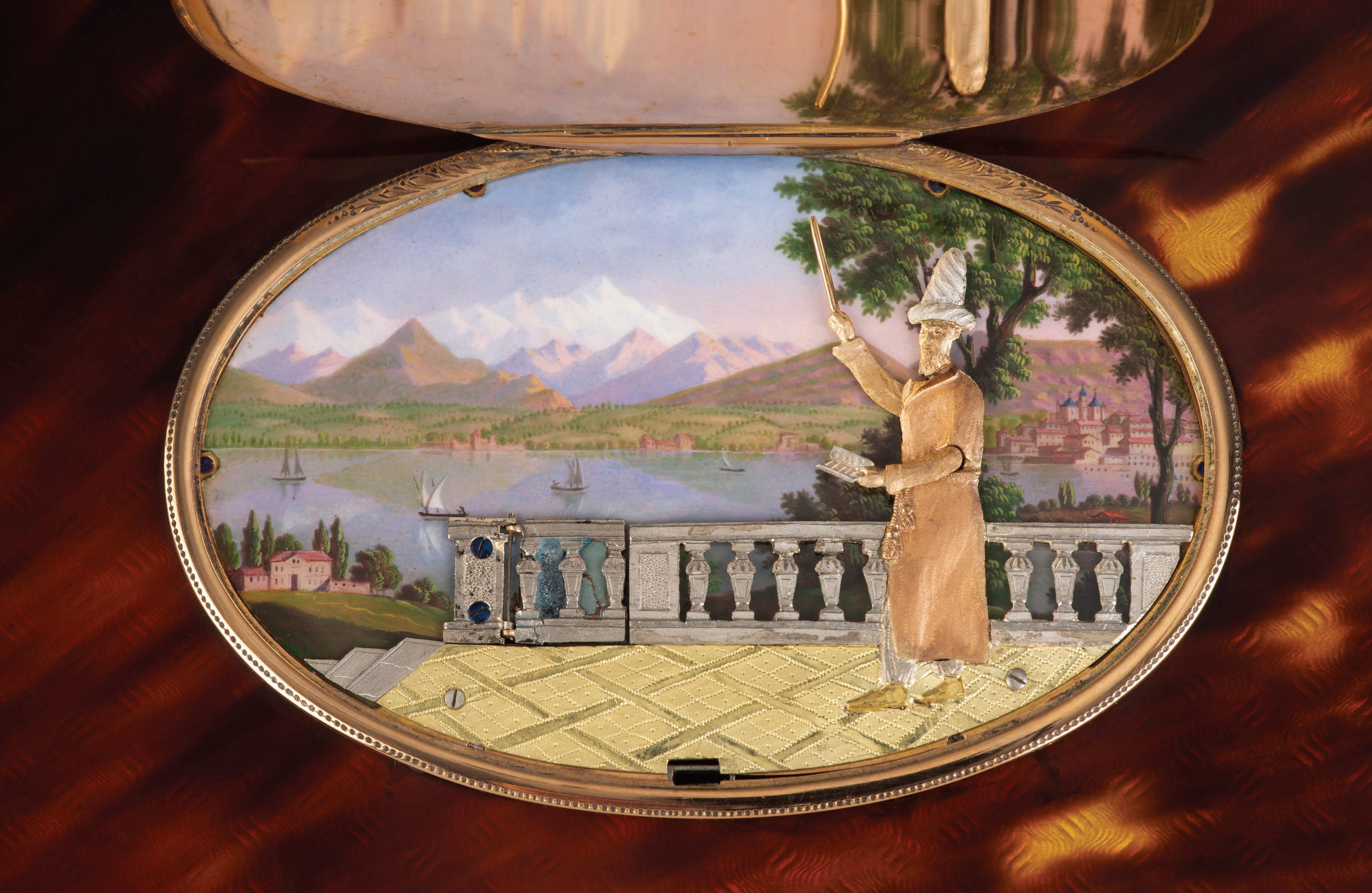
On the exterior, the automaton appears as a refined book of the period. Yet inside lies a marvel: two sliders, one for selecting a question in gold enamel, and another to activate the mechanism. Choose a question—“What is the greatest happiness?”—and the show begins. A gold panel lifts to reveal a finely enameled terrace overlooking Lake Geneva and Mont Blanc. A magician appears, consulting his book, tapping a wand four times, and revealing the answer hidden behind a balustrade: “To be loved.”
Only six similar magician automatons exist in the world, all in snuffbox form. This book, however, remains singular. Its mechanical complexity is unmatched. Dr. Sandoz used it as a livre d’or, a guestbook for visitors to his villa—including Charlie Chaplin, European nobility, and avant-garde collectors. It has only been lent once: for an exhibition at La Vieille Russie, New York, in 1950.
More than an object, the magician automaton is a memory in motion. It blends time, technique, and imagination, reminding us that before the digital age, wonder was crafted by hand. It is a whisper from the past, asking us still: What is happiness?
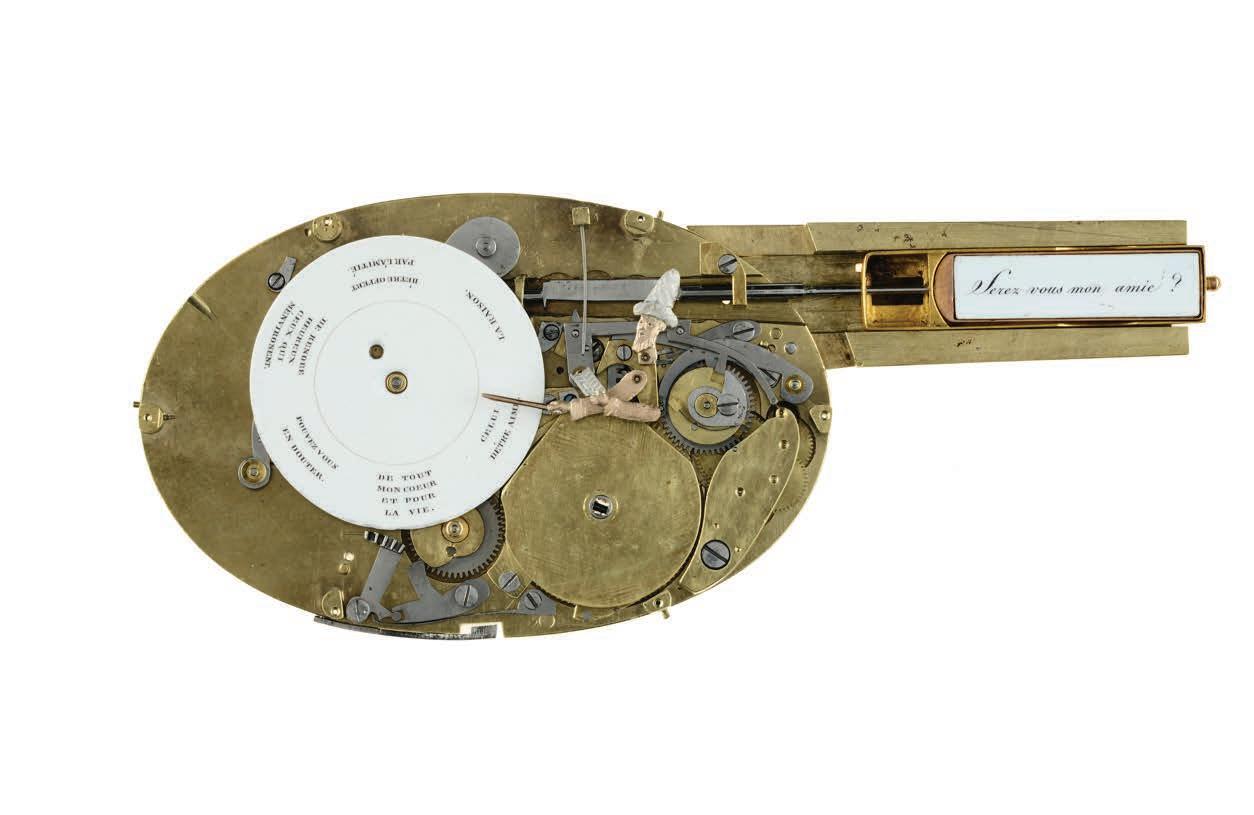
1823年、
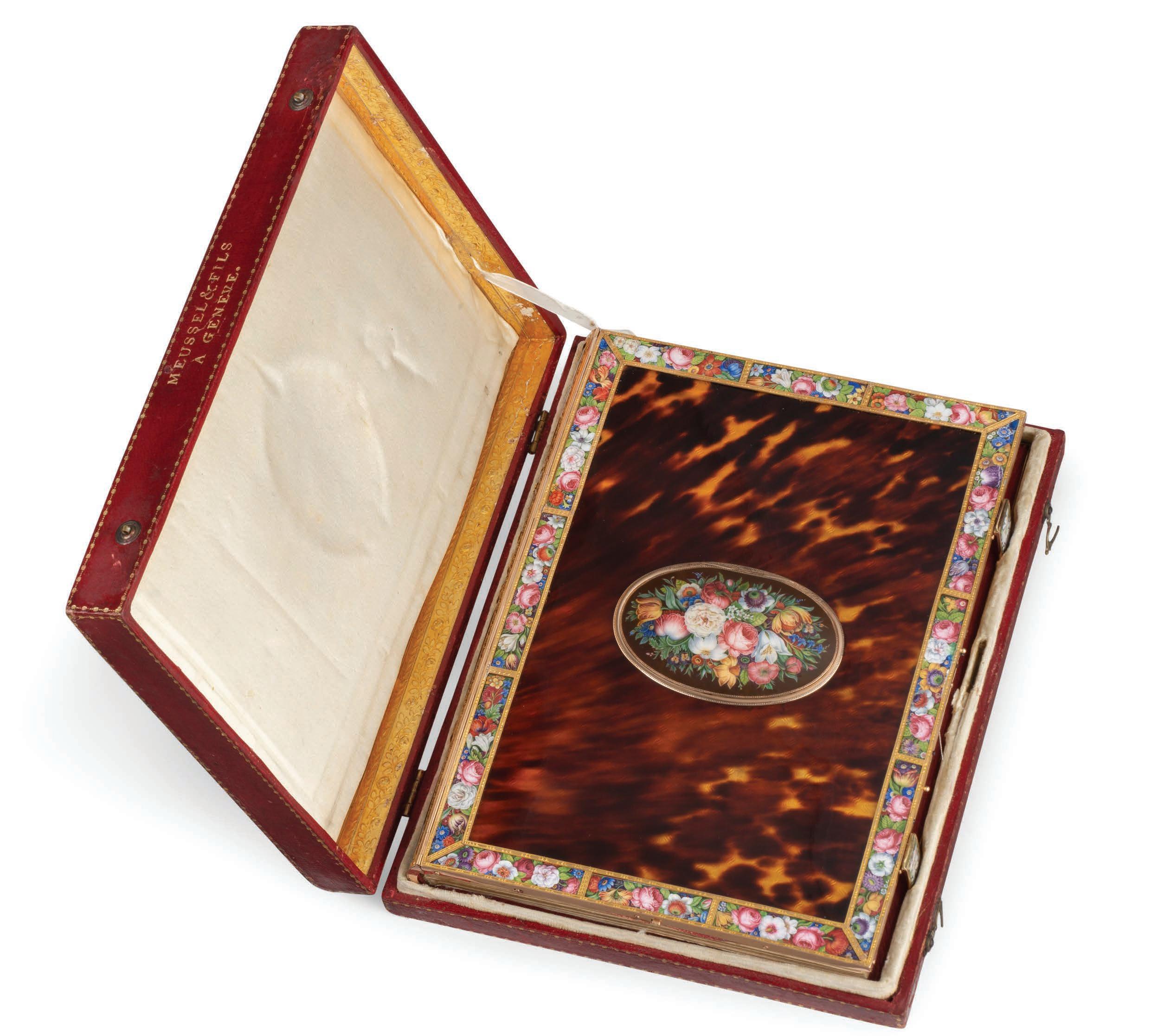
このオートマトンは、ただの機械でも、書 物でもない。手で創られた“記憶の装置” であり、問いかけ続ける芸術である。デジ タル以前の世界に、これほど優雅な“問い” があっただろうか――「幸福とは何か?」
類似の魔術師オートマトンは世界に6点 存在するが、いずれもスナッフボックス 型。この“書籍型”は唯一無二である。 その機構の精密さは群を抜き、サンドス は本書をゲストブックとして使用してい た。チャーリー・チャップリン夫妻をは じめ、王侯貴族や芸術家が訪れ、感嘆の 言葉を残した。1950年、ニューヨーク のラ・ヴィエイユ・リュスでの展示を除 き、外部貸し出しは一度きりである。 魅惑の機構
外見は当時の高級書物そのもの。しかし 内部には、選択式の金とエナメルのスラ イダーが隠されている。質問(例:「最 も大きな幸福とは?」)を選び、スライ ダーを閉じると魔法が始まる。前面の金 のパネルが開き、レマン湖とモンブラン を望むテラスに魔術師が現れる。書を読 み、杖でバルコニーを4度叩くと、答え が現れる――「愛されること」。

For over a century, Leica has been synonymous with photographic excellence. From the invention of the first 35mm camera to its celebrated minimalist design language, the German brand has defined moments through lenses. But now, Leica is capturing time itself—through its meticulously crafted mechanical watches. Since the debut of Leica Watches in 2022, the brand has approached horology with the same obsessive attention to precision and aesthetics that made it a legend in optics. For Dr. Andreas Kaufmann, Chairman of the Supervisory Board at Leica Camera AG, the move into watchmaking wasn’t just a diversification—it was a natural evolution.
“We define our expertise through six key areas— optics, mechanics, electronics, software, design, and retail,” explains Kaufmann. “In watchmaking, three of these—mechanics, design, and distribution—fit perfectly.”
Leica’s mechanical heritage dates back to its founder, Ernst Leitz I, who trained as a watchmaker in Switzerland before applying his skills to microscopes and cameras. As Henrik Ekdahl, Managing Director of Leica’s watch division, puts it:
That early knowledge of precision components was foundational. It’s part of our DNA. " "
ジュネーブ—— 1世紀以上にわたり、 ライカは常に卓越した写真の頂点に立 ち続けてきた。世界初の35mmカメ ラの発明に始まり、ミニマリズムを極 めたデザイン言語の構築に至るまで、 このドイツの名門ブランドはレンズ越 しに時代の決定的瞬間を切り取ってき た。そして今、ライカは新たなる挑戦 へと踏み出す。すなわち、緻密に設計 された機械式時計を通じて、「時間」 そのものを捉えるという試みである。
2022年、ライカWatchの誕生をも って、同ブランドは時計製造の世界へ と静かに歩を進めた。そのアプローチ には、光学の分野において伝説と化し た精緻さと美意識への徹底したこだわ りが、寸分違わず投影されている。
Leica Camera AG 監査役会会長兼筆 頭株主 アンドレアス・カウフマン博 士にとって、この事業は単なる多角化 ではない。むしろ、それはライカとい う存在の自然かつ必然的な進化であっ た。
「われわれの専門領域は、光学、機 械、電子、ソフトウェア、デザイン、 そして小売という6つの柱に支えられ ている。そのうち、機械、デザイン、 流通は時計製造において見事に符合す る」とカウフマン博士は語る。
ライカの機械的伝統は、創業者エルン スト・ライツ1世まで遡る。彼はス イスにて時計職人としての修業を積 み、その手業と知見を顕微鏡、そして カメラの世界に注ぎ込んだ。ライカ時 計部門のマネージングディレクターで あるヘンリック・エクダール氏は次の ように述懐する。
精密部品に関す る初源的な知識 こそが、われわ れの基盤であり、 それはブランド の遺伝子に深く 刻まれている。
The ZM 1 and ZM 2 marked Leica’s debut, but true to form, the journey from concept to production took years. The watches are hand-wound and made in partnership with German and Swiss specialists. The attention to detail extends even to the iconic red dot, which is only visible on the ZM11 and ZM 12 when the button for the Easy Change strap change system is pressed—a subtle nod to the brand’s visual language.
“You won’t see a red dot screaming at you from the dial,” says Kaufmann. “We wanted it to be discreet, just like in our cameras.” Ekdahl elaborates on the design philosophy: “Leica is about reduction. Every feature in these watches has a purpose.” One standout is the power reserve indicator, inspired by the analog shutter mechanism of the Leica M6. Another is the push-crown, which allows precise time setting by stopping the second hand exactly at 12.
“You press, not pull. No guesswork—just precision,” says Ekdahl. “That’s typical German engineering.”
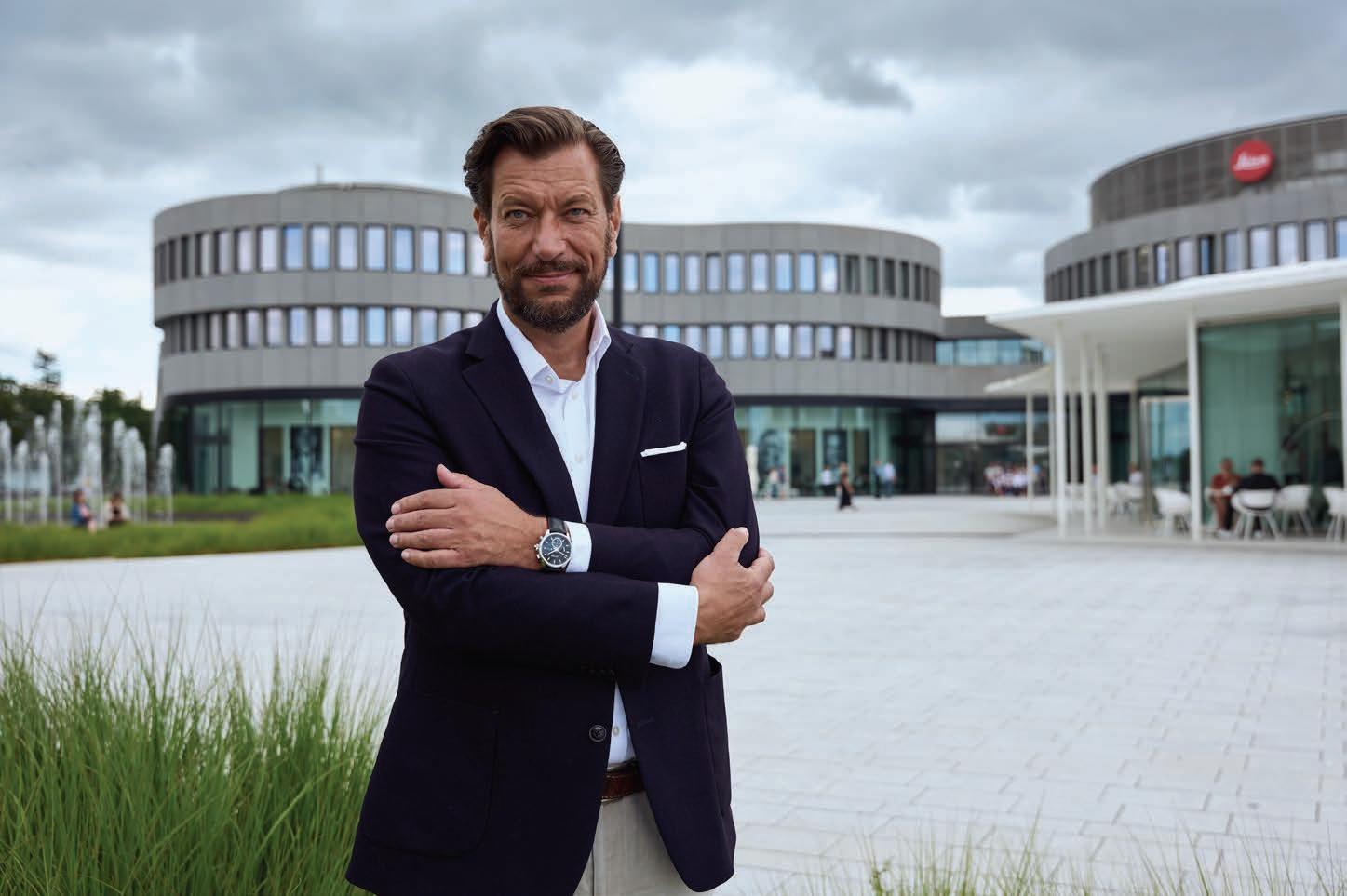

In 2023, Leica introduced its Monochrom editions, drawing inspiration from its legendary black-and-white cameras. These models feature ultra-reduced designs with low contrast and subtle branding—an homage to purity and discretion.
“It’s probably one of the most discreet luxury watches out there,” notes Ekdahl. “And that’s why people love it.”
For the ZM 11 and ZM 12, Leica partnered with Swiss movement maker Chronode. While these automatic models lean less on hardware inspiration, they still echo the soul of photography— particularly in their interplay with light and shadow.
“The dial looks completely different depending on how the light hits it. It’s just like in photography,” says Ekdahl.
The domed sapphire glass mimics a camera lens, while the engraved-free movements underscore Leica’s industrial aesthetic—clean, honest, and refined.
To bridge photography and horology even further, Leica partnered with Kristian Haagen, a watch expert and Leica enthusiast.
“Kristian lives in both worlds,” says Ekdahl. “We asked him to photograph the ZM 11 in his environment, through his lens. The result was storytelling at its best.”
Haagen’s personal history with Leica—sparked by flipping through National Geographic as a child—adds a layer of authenticity to the brand’s expanding narrative.
ライカは、写真と時計製造という二つの世界をさ らに結びつけるべく、時計専門家にしてライカ愛 好家でもあるクリスチャン・ハーゲン氏とのコラ ボレーションを実現させた。
「クリスチャンは、写真と時計の両方の世界を知 る人物だ。我々は彼に、彼自身の生活空間で、 ZM 11を彼の視点から撮影してもらった。その
写真には、まさに物語そのものが映し出されてい た」とエクダール氏は語る。
ハーゲン氏がライカに惹かれたきっかけは、少年 時代にナショナルジオグラフィック誌を夢中でめ くっていた体験にある。その原体験が、ライカと いうブランドの物語に、いっそうの説得力と詩的 な広がりを与えている。

機能と造形の融合、それがライカの流儀
ZM 1とZM 2はライカにと って時計分野への初の参入と なったが、その実現までの道 のりは決して平坦ではなく、 構想から製品化までには数年 を要した。これらの時計は手 巻き式であり、ドイツおよび スイスの専門職人との協業に より製造されている。
その細部へのこだわりは、象 徴的な「レッドドット」にま で及んでいる。このドット は、ZM 11およびZM 12 においてのみ、イージーチェ ンジシステムのボタンを押し たときに姿を現す。視覚的な 主張を控え、ブランドの美学 をそっと物語る演出である。
「文字盤の上にレッドドット が目立つように配置されてい ることはない。それは控えめ であってほしかった。我々の カメラと同じように」とカウ フマン博士は語る。
エクダール氏はこのデザイン 哲学をさらに掘り下げる。
「ライカの精神とは、究極の 削ぎ落としにある。時計に備 わるすべての機能は、意味と 目的を持って存在しているの だ」。
その注目すべき特徴のひとつ は、「ライカM6」のシャッ ターカーテンに着想を得たパ ワーリザーブインジケーター である。さらに、特許取得済 みのプッシュ式リューズは、 秒針を正確に12時で停止さ せる、極めて精密な時刻設定 を可能にした。
「引くのではなく、押す。そ こに推測の余地はない。ある のはただ、完璧な精度のみ。 それこそが、ドイツ的エンジ ニアリングの真髄である」と エクダール氏は語る。
2023年、ライカは「モノ クローム・エディション」 を発表した。これは、同社 が誇る「ライカM11モノ クローム」にインスパイ アされたコレクションであ り、極限まで要素を削ぎ落 としたデザイン、抑制の効 いたコントラスト、控えめ なブランド表記により、純 粋さと慎み深さを体現して いる。
「おそらく、世界でもっと も控えめなラグジュアリー ウォッチのひとつだろう。 だからこそ、この時計は 人々に愛されるのだ」とエ クダール氏は述べる。
ZM 11およびZM 12で は、ライカはスイスのムー ブメント専門メーカーであ るクロノード社と提携し た。これらの自動巻きモデ ルは、物理的機構に直接的 な着想は得ていないもの の、光と影の織りなす表情 を通して、写真芸術の精神
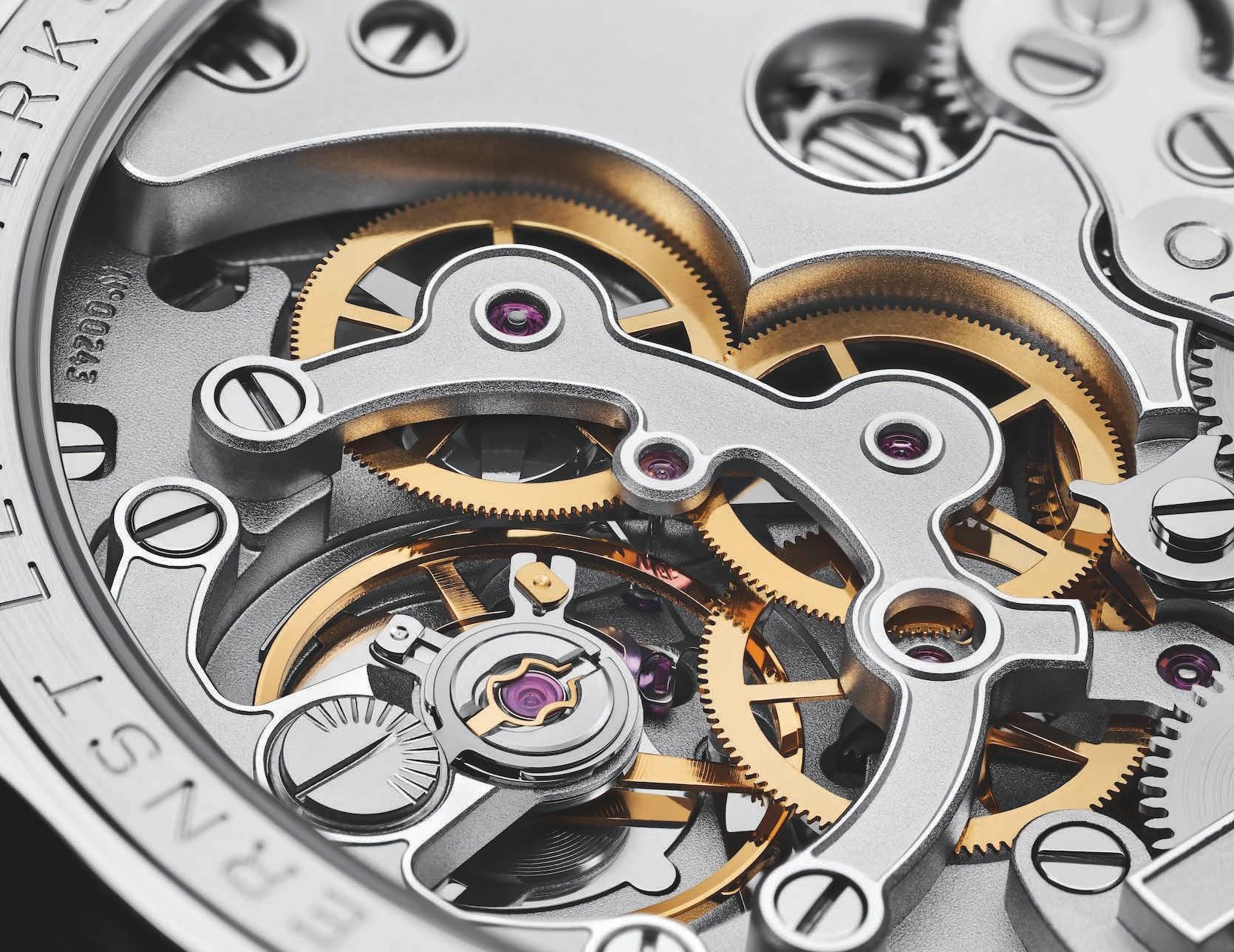
While developing a new inhouse movement would take another five to seven years, Leica is focused on refining its current lines—experimenting with new materials, colorways, and design elements. And yes, they’re already dreaming about future complications.
“Personally, I’d love an alarm function,” muses Kaufmann. “You’re in a Tokyo hotel, your phone’s dead, and your Leica watch wakes you up. That’s a traveler’s dream.”
With its blend of German engineering, photographic heritage, and minimalist beauty, Leica Watches may be young—but its vision is anything but short-term.
“From Germany to the world,” says Kaufmann. “That’s the Leica way.” In a world saturated with timepieces, Leica doesn’t shout. It simply focuses—just like its cameras.
自社製ムーブメントの開発には、 さらに5年、7年、あるいは10 年の歳月が必要であろう。しかし ライカは、既存のラインを磨き上 げることに注力している。新素材 の探求、新たなカラーパレット、 斬新なデザイン要素の試行。そし てもちろん、将来的な複雑機構の 構想にもすでに着手している。
「個人的には、アラーム機能を 搭載したいと思っている。たと えば東京のホテルで、スマー トフォンの電源が切れてしま ったとしても、ライカの腕時 計が旅人を優しく目覚めさせ てくれる。それは、旅人にと っての理想郷のような夢であ る」とカウフマン博士は語る。 ドイツのエンジニアリング、写 真という文化資産、そして静謐 なるミニマリズムの融合。ライ カWatchは若きブランドであ る。しかし、その視線の先にあ るものは、決して一過性の未来 ではない。「ドイツより、世界 へ。それが、ライカの流儀であ る」とカウフマン博士は語る。 時計が溢れるこの時代におい て、ライカは声を張り上げる ことはない。ただ静かに焦点 を合わせ続ける。それは、ラ イカのカメラが長年貫いて きた姿勢そのものである。
写真展「
Renowned photographer TAKAY presented his solo exhibition, Tesseract, from April 17 (Thu) to May 31 (Sat), 2025, at Akio Nagasawa Gallery in Ginza, Tokyo. The show marked TAKAY’s first new body of work in three years, offering a fresh perspective on fleeting bodily movements and transformations that awakened the viewer’s senses.
In Tesseract, TAKAY captured the raw silhouettes formed by muscular tension as well as the delicate contours that emerged when that tension faded. Through his lens, these ephemeral moments were reconstructed into powerful visual narratives. Using light and shadow with striking precision, he explored the latent force and potential of the human body, rendering its movement into a dynamic visual language. TAKAY described the exhibition as an embodiment of the process of “formation—transformation—reconstruction,” illuminating the body’s energy from a new perspective through photography.
Coinciding with the exhibition, TAKAY’s photo book Tesseract was also released. Limited to 900 signed and numbered copies, the book offered a deeper insight into his artistic vision and approach.
写真家TAKAYの最新個展 「Tesseract」が、2025年4月17 日(木)から5月31日(土)ま で、東京・銀座のAkio Nagasawa Galleryで開催されました。本展は、 TAKAYが3年ぶりに発表する新作 で、身体の瞬間的な動きや変化を独 自の視点で捉え、観る者に新しい感 覚を呼び起こしました。
TAKAYは、筋肉の緊張が生み出す 力強いシルエットや、力が抜けた瞬 間の儚い形を写真に収め、それらの 一瞬の重なりを再構築することを試 みています。彼の作品は、身体が持 つ潜在的な力や可能性を視覚的に再 構築し、光と影を巧みに使ってその 動きを表現します。TAKAY自身は、 この写真展で「形成—変化—再構築」 というプロセスそのものを表現し、 写真を通して新たな視点で身体のエ ネルギーを浮き彫りにしました。
本展に合わせて、TAKAYの新しい 写真集『Tesseract』も出版されま した。サインとナンバー入りで限定 発行されたこの一冊は、TAKAYの 世界観をより深く知ることができる 貴重な作品となった。


In April 2025, the Festival Beethoven à Beaune returned with a heartfelt tribute to the enduring power of family legacies in shaping classical music. Held from April 3 to 6, the festival’s theme, “Domaine Familial,” shone a spotlight on the deep connections within musical dynasties and the inspiration they have passed on through generations. Set against the historical beauty of Beaune, the festival offered a rich exploration of heritage, artistry, and community under the expert direction of President Frédéric Mugnier and Artistic Director Sung-Won Yang.
For Mugnier, the theme of family legacies struck a personal chord. “In Burgundy, estates are passed down through families, much like the great composers who passed their musical legacies to future generations,” he shared. The 2025 festival celebrated these interconnected family stories by showcasing the works of Johann Sebastian Bach, Felix Mendelssohn, and the Schumann families. “These dynasties influenced one another and future generations, creating music that has stood the test of time,” Mugnier reflected.
This year’s program marked a distinctive departure from Beethoven’s own works—an intentional choice that Mugnier was eager to explain. “Beethoven’s influence is all-encompassing. He was shaped by the composers before him, and his impact resonates in the works of those who came after. Though his music was not featured in this edition, his presence was felt
throughout the festival.”
The concerts took place in Beaune’s most historic venues, including the iconic Hospices de Beaune and the Lanterne Magique, where the architecture itself offered a sense of connection to the music.
“These spaces were vital to the experience. They linked the music’s history with its present-day audience,” Mugnier noted.
The festival also extended its reach to Dijon, offering an expanded program to engage even more listeners.
The performances not only celebrated the musical families being honored but also highlighted the personal connections between the artists. The program featured duos such as Hélène and Eric Levionnois, as well as baroque specialists Kaori Uemura and Ryo Terakado, whose artistry was deeply rooted in their cultural heritage.
“When performers share a personal connection to the music or to each other, it creates a unique energy that the audience can truly feel,” Mugnier explained.
The festival also continued its outreach efforts to connect students and educators with the artists. Reflecting on the success of the previous year’s initiative, Mugnier recalled: “It was powerful to see students realize that music is not just streamed content— it is created by real people. That connection is irreplaceable.”
As the Festival Beethoven à Beaune continued to grow, Mugnier remained committed to balancing tradition and innovation. “Like a
great vintage wine, each edition should carry a sense of familiarity while offering something new and unexpected. We are not trying to be radical or predictable—we want to stay grounded and refreshing.”
With the 2025 edition, Mugnier and his team delivered an unforgettable celebration of both the region’s musical and cultural heritage. “Music and wine speak beyond language. They connect people across time and generations. That’s the spirit we’ve tried to capture in this festival.”

音楽と伝統の絆を讃えて
ミュニエ氏にとって、「ドメーヌ・ファミリア ル」というテーマは個人的な共鳴を呼び起こすも のでした。「ブルゴーニュでは、偉大な作曲家た ちが音楽の遺産を後世に伝えたように、ドメーヌ も家族を通じて受け継がれていきます」と語りま した。2025年の音楽祭では、ヨハン・ゼバステ ィアン・バッハ、フェリックス・メンデルスゾー ン、シューマン家の作品が紹介され、音楽一族の 密接な物語が祝福されました。「これらの音楽家 の一族は、お互いに、そして後世に影響を与え、 時代を超えて愛される音楽を創り上げてきたので す」と振り返りました。
今年のプログラムは、ベートーヴェン自身の作品 から意図的に距離を置く特徴的な構成となってい ました。その理由についてミュニエ氏は、「ベー トーヴェンの影響力は計り知れません。彼は先人 の作曲家たちに影響を受け、彼の存在は後の世代 の作品にも響き続けています。今回彼の音楽は取 り上げませんでしたが、その精神は音楽祭のあら
ゆる場面に息づいていました」と説明しました。
演奏は、象徴的なオスピス・ド・ボーヌやランテ ルヌ・マジックといった、ボーヌで最も歴史的な 会場で開催されました。建築自体が音楽とのつな がりを感じさせる空間であり、「これらの空間は 音楽祭に欠かせない要素でした。過去と現在の聴 衆をつなぐ役割を果たしてくれました」とミュニ エ氏は述べました。さらに音楽祭はディジョンに も拡大し、より多くのリスナーにプログラムが届 けられました。
今回のパフォーマンスは、音楽一族の作品を称え るだけでなく、出演者同士の個人的な絆も強調さ れました。エレーヌとエリック・ルヴィオノワの デュオ、バロック音楽の専門家である上村かおり 氏と寺神戸亮氏の演奏など、文化的遺産に根ざし たアーティストたちが出演し、「演奏者同士が音 楽や互いに深い関係を持っているとき、その場に 生まれる特別なエネルギーは、観客にもしっかり と伝わります」とミュニエ氏は語りました。

フェスティバルでは、若い世代をアーティストとつなぐアウトリーチ活 動も継続されました。前回の成功を受けて、ミュニエ氏は「学生たちが、 音楽はただストリーミングされるものではなく、“生きた人間”によっ て生み出されるものであることを理解していく姿は、非常に感動的でし た」と回顧しています。
成長を続けるボーヌ・ベートーヴェン・フェスティバルにおいて、ミュ ニエ氏は伝統と革新の両立を大切にしてきました。「毎年のヴィンテー ジワインのように、慣れ親しんだ風味を持ちながらも、その年だけの新
しさを持つ存在でありたい。革新すぎず、また退屈でもない、そんな絶 妙なバランスを追求しています」。
2025年のフェスティバルを通して、ミュニエ氏は地域の音楽的・文化 的遺産を讃える忘れがたい体験を提供しました。「音楽もワインも、言 葉を超えて人の心に響くもの。時代を越え、世代を越えて、人々の心を 結びつけてくれます。それこそが、この地で生まれた文化を通じて私た ちが目指していることなのです」。
Rooted in Time: The Quiet Excellence of
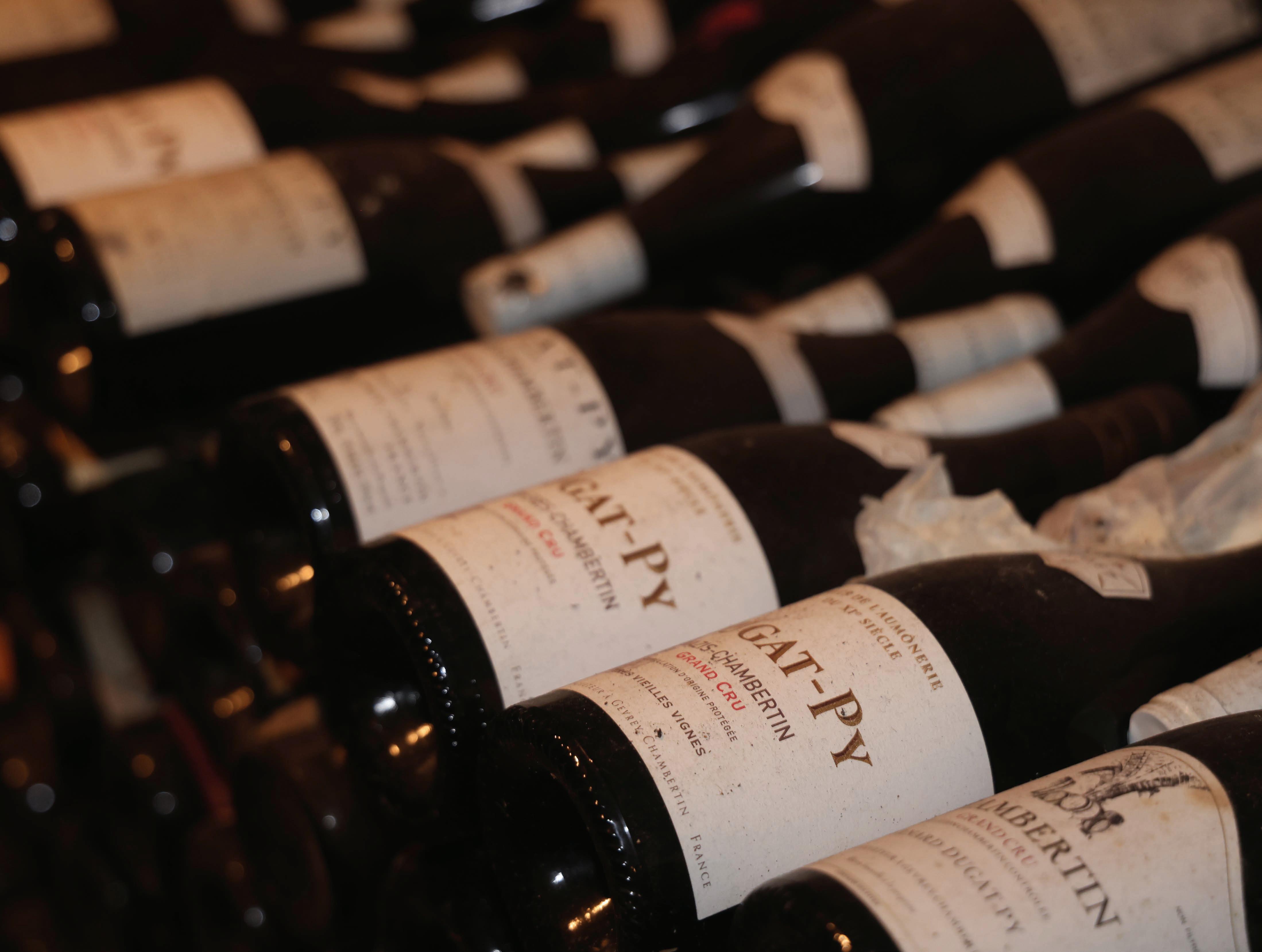
コート・ド・ニュイの風景が今も穏やかに 時を刻むジュヴレ・シャンベルタン村。こ の地に根を張るドメーヌ・デュガ・ピィは、 17世紀から続くブルゴーニュの伝統を受け 継ぎながら、十三代にわたりブドウと精神 を静かに育んできた。世代を超えて伝えら れてきたのは、畑と向き合い、耳を澄まし、 自然のリズムに寄り添うという、静かで揺 るぎない哲学である。
“Old vines have small roots, and there is a lot of energy in them,” Loïc explains. It is this energy — concentrated, vibrant, yet restrained — that defines the style of Dugat-Py’s wines. From the mineral-laced finesse of their village appellations to the structured elegance of their Premier and Grand Crus, the wines are remarkably precise. They reveal the personality of each parcel, rather than the imprint of the winemaker.
Each decision in the vineyard and cellar is guided by intuition and observation. Whether to keep stems or de-stem, for instance, is decided by tasting the grapes at harvest. Similarly, new oak is used judiciously: about 30–45% for the Premier and Grand Crus, and just 15% for the village-level wines. The goal, always, is balance — never domination.
One of the domaine’s defining commitments is its long-standing practice of organic viticulture. “We’ve been working organically for 20 years,” says Loïc. “We don’t use any chemical products — no pesticides, no synthetic fertilizers. Only contact products, which don’t enter the sap of the vine and therefore don’t end up in the grapes.” This is as much about protecting the land as it is about ensuring purity in the glass. “It’s important for the people who work in the vineyard, and also for those who drink our wines,” he adds.
Domaine Dugat-Py continues to operate on a human scale, with just over fifteen hectares of vineyards and low yields that rarely exceed 20 hectolitres per hectare. The estate’s wines, often produced in very limited quantities, are known for their clarity, structure, and ability to reflect the character of each parcel.
土壌との調和
「古木の根は浅く、そのぶんエネルギーが凝縮されています」 とロイックは説明する。この凝縮されたエネルギー──緊張感 に満ち、活力を秘めながらも抑制の効いた力──こそが、ドメ ーヌ・デュガ・ピィのワインのスタイルを特徴づけている。ミ ネラル感に富んだ村名ワインから、構造美を備えた一級畑・特 級畑のワインに至るまで、その精緻さは際立っている。それぞ れの区画の個性が明確に表れ、造り手の痕跡よりもテロワール の声が際立つ。
畑とセラーにおけるすべての判断は、観察と直感に基づいて行 われる。たとえば、収穫時のブドウの味を確かめながら、除梗 を行うか否かを決める。また、新樽の使用は極めて慎重であ り、一級・特級ワインでは約30 ~ 45%、村名ワインではわ ずか15%にとどめられる。その目的は、あくまでバランスを 保つことであり、樽の存在感を前面に出すことではない。
ドメーヌの信条の一つに、20年以上にわたって続けられてき た有機栽培がある。
「私たちは一切の化学薬品を使っていません。農薬も合成肥料 も使用せず、植物の樹液に入り込まない“コンタクト製品”の みを使っています」。
それは土地を守るためであると同時に、グラスの中に現れるワ インの純度を守るためでもある。
「畑で働く人々にとっても、ワインを飲む人々にとっても大切 なことです」と彼は強調する。
ドメーヌ・デュガ・ピィは現在も人の手が届く規模で運営され ており、畑の総面積は15ヘクタール強、収量は1ヘクタール あたり20ヘクトリットルを超えることは稀である。限られた 生産量ながら、そのワインは明快で構造的、そしてそれぞれの 区画の個性を鏡のように映し出す。
Today, it is Loïc Dugat-Py, son of Bernard Dugat, who carries forward the domaine’s vision. “I began working here when I was 16,” he says. “I am the 13th generation.” From an early age, Loïc learned not only the technical aspects of viticulture but also the subtler lessons: how to read the vines, how to respect the land, and how to listen — deeply — to the rhythm of nature. “Our cellar is the symbol of our identity,” he adds. “It hasn’t changed since I was born. The label on our bottles is, in fact, an image of our cellar.”
This cellar, located in the heart of Gevrey-Chambertin, dates back to the 11th century and was once part of the Abbey of SaintBénigne in Dijon. It is in these ancient vaulted spaces, carved from stone centuries ago, that the wines are aged — not as a matter of style, but of continuity. Here, the past is not preserved in nostalgia but lived in daily practice.
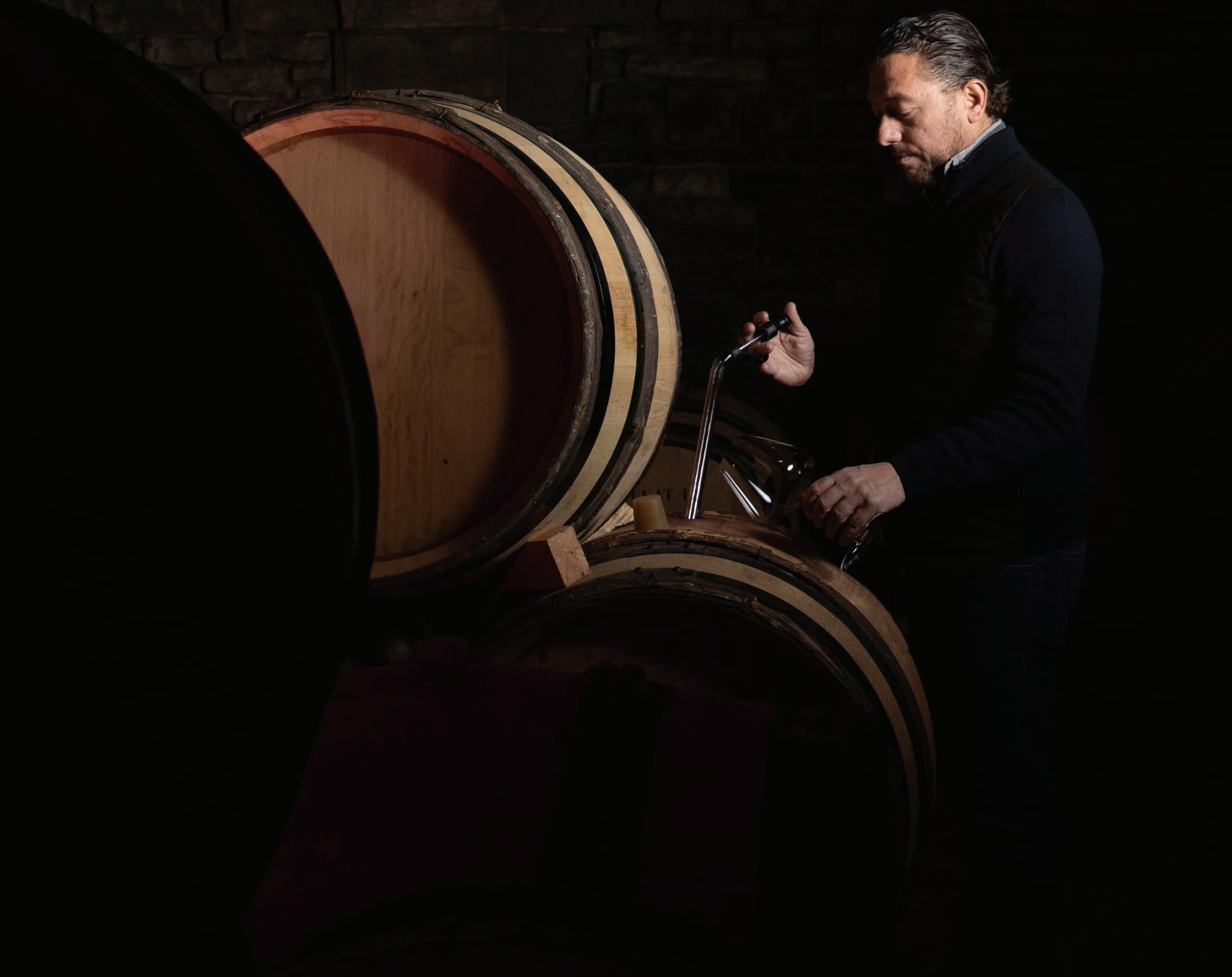
At the core of Domaine Dugat-Py’s winemaking approach is a deep respect for the singular expression of Pinot Noir. “We work with only one grape variety,” Loïc notes. “That’s our identity.” The domaine’s vineyards, which include some of the oldest vines in Burgundy, are predominantly located in Gevrey-Chambertin — many planted more than a century ago. One cuvée, ”Cœur de Roy“, comes from vines over 100 years old, planted by Loïc’s great-great-great-grandfather.
現在、ドメーヌを率いるのはベルナール・デュガの息子、ロイック・ デュガ・ピィである。
「16歳からここで働いています。私で13代目です」と語るロイック は、栽培や醸造の技術だけでなく、ブドウ樹の読み方、土地への敬意、 そして自然のリズムに深く耳を傾けるという、より繊細な教えを幼い 頃から学んできた。
デュガ・ピィのワイン造りの核には、ピノ・ノワールという唯一の品 種に対する深い敬意がある。
ドメーヌの畑は主にジュヴレ・シャンベルタンに広がり、その多くに はブルゴーニュで最も古いブドウ樹が残っている。中でも「クール・
「私たちのセラーは、ドメーヌのアイデンティティの象徴です。私が 生まれたときから何も変わっていません。ボトルのエチケットに描か れているのも、このセラーの姿です」 このセラーはジュヴレ・シャンベルタン村の中心部に位置し、起源は 11世紀、ディジョンのサン・ベニーニュ修道院にまで遡る。何世紀も 前に石をくり抜いて築かれたこのアーチ型の空間で、ワインは静かに 熟成されている。それはスタイルのためではなく、継承のため。ここ では過去は懐古の対象ではなく、日々の営みの中で今も息づいている。

“We’re not trying to make ‘powerful’ wines,” Loïc explains. “We’re trying to make wines that reflect where they come from.”
Guided today by Loïc Dugat-Py, the domaine blends centuries of tradition with an evolving awareness of the land’s needs. From the deep roots of century-old vines to the quiet stability of the 11th-century cellar, each element plays a role in shaping the identity of the wines. What emerges is not a fixed style, but an ongoing conversation between history, terroir, and the people who cultivate it — thoughtfully, season after season.
「私たちは“力強いワイン”を造ろう としているのではありません」ロイ ックのこの言葉が示すとおり、目指 しているのはあくまで、土地そのも のを語るワインなのである。
13代目ロイック・デュガ・ピィが導 く今日のドメーヌは、何世紀にもわ たる伝統に、土地の声に耳を澄ます 現代的感性を重ねている。樹齢百年 を超える古木の根の奥深さから、11 世紀のセラーに宿る静けさまで── すべての要素が、このワインの本質 を形づくっている。そこにあるのは、 決して固定されたスタイルではない。 歴史とテロワール、人と自然が交わ す、静かで真摯な対話──季節ごと に紡がれる、その継続の物語である。

テロワールの声を引き出すという芸術
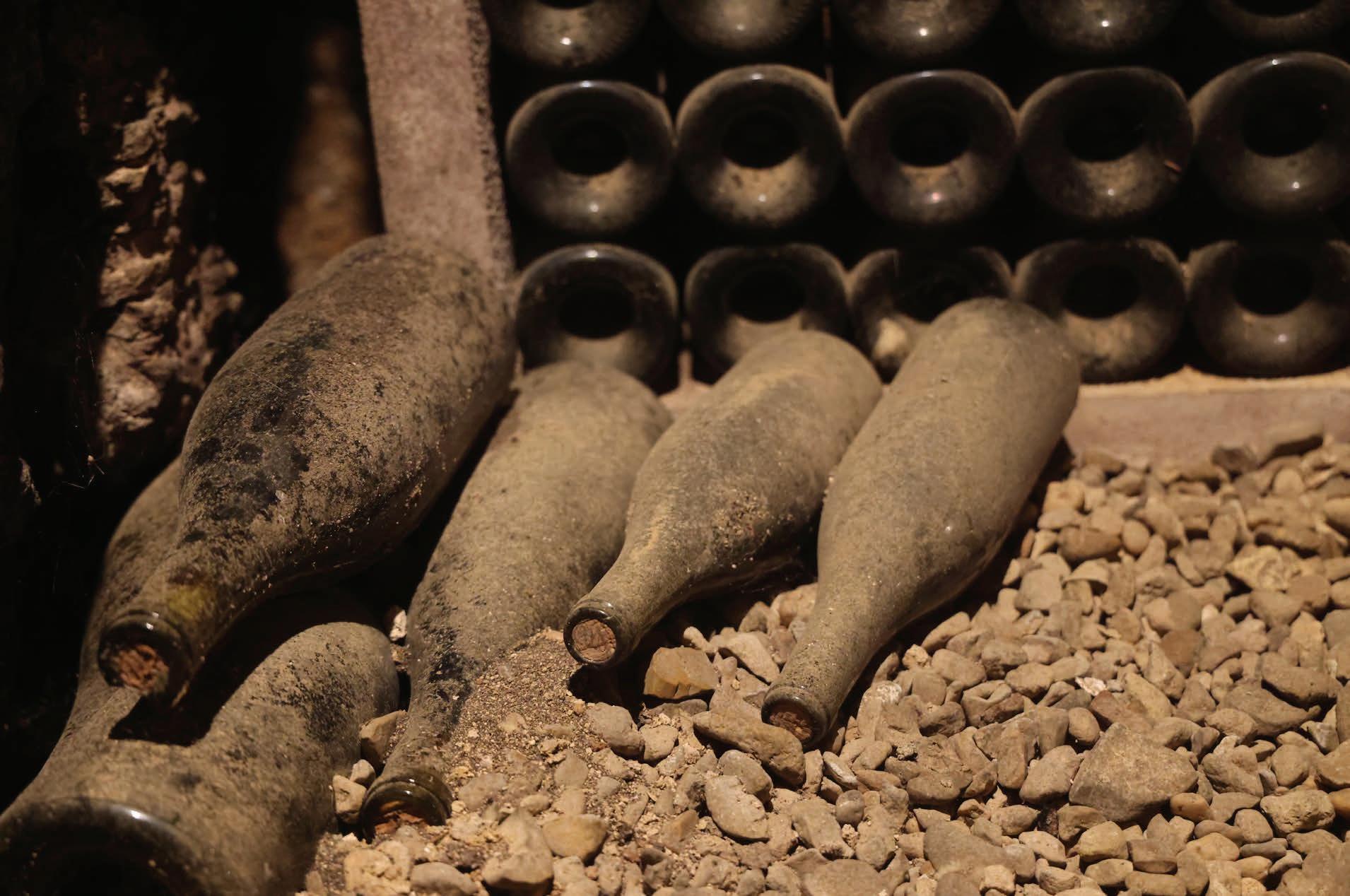

Copyright© Domaine Jacques Prieur
— From the Science of Terroir to the Art Beyond
ブルゴーニュに理性をもたらした女性醸造家の肖像 — テロワールを科学する、その先にある芸術
Gublin’s name stands as a symbol of transformation in the French wine industry. In a field long dominated by men, she brought precision and deep understanding of terroir, introducing a new dimension to the wines of Burgundy.
Since 1990, Gublin has served as technical director at the prestigious Domaine Jacques Prieur, where she has led innovation with scientific acumen and unwavering dedication. In 1998, she was named “Winemaker of the Year” by La Revue du Vin de France (RVF)—the first woman to receive this title in the magazine’s history.
ナディーヌ・ギュブラン——その名は、フランス のワイン業界における変革の象徴である。長らく 男性中心とされてきた醸造の世界において、彼女 は卓越した技術と深いテロワールへの理解をもっ て、ブルゴーニュに新しい風を吹き込んだ。
年には、フランスの権威あるワイン専門誌『La Revue du Vin de France(RVF)』にて「年間 最優秀醸造家」に選出される。この称号を女性が 受けたのは、同誌史上初のことだ。
Her wines embody both strength and finesse, quietly yet distinctly expressing the diverse character of Burgundy’s complex terroir. They are not merely products of craftsmanship but eloquent “poetry,” born of a dialogue between soil, climate, science, and passion.
1990年より名門「ドメーヌ・ジャック・プリウ ール(Domaine Jacques Prieur)」で醸造責 任者を務めるギュブラン氏は、醸造現場を技術 面で支え、ドメーヌ全体を牽引してきた。1998
彼女が手がけるワインは、力強さと繊細さを併せ 持ち、ブルゴーニュという複雑で多様な土地の個 性を静かに、しかし確かに伝える。それは単なる 職人技ではなくブルゴーニュの土壌が語る、理知 と感性の結晶とも言える存在だ。


Born in 1958 in Aube, Champagne, to a family of grain farmers, Gublin developed an early sensitivity to the connection between land and life. After high school, she pursued viticulture and oenology at the University of Dijon—a rare path for women in 1970/1980 France. Immersed in microbiology and chemistry, she became especially fascinated by the role of yeast in fermentation.
Following her studies, she worked at Laboratoires SaintPierre in the Mâconnais region, providing technical support to wineries in Beaujolais and Mâcon. There, she learned to bridge experience and analysis— blending field expertise with scientific method.
Gublin gained international acclaim after joining Domaine Jacques Prieur as head winemaker in 1990. Based in Meursault, the domaine owns an array of Grand Cru vineyards such as Montrachet, Corton, Échézeaux, Chambertin, and Musigny.
Under her leadership, the estate underwent a profound evolution. Gublin introduced parcel-byparcel vinification, tailoring methods to the microclimate and soil of each vineyard. This precise approach enabled the expression of individual terroirs in their purest form.
She also shifted harvest timing to allow for greater ripeness, achieving wines that balance rich fruit concentration with elegance. Her meticulous control of fermentation temperature and use of gravity flow systems exemplify a commitment to detail at the micro level.
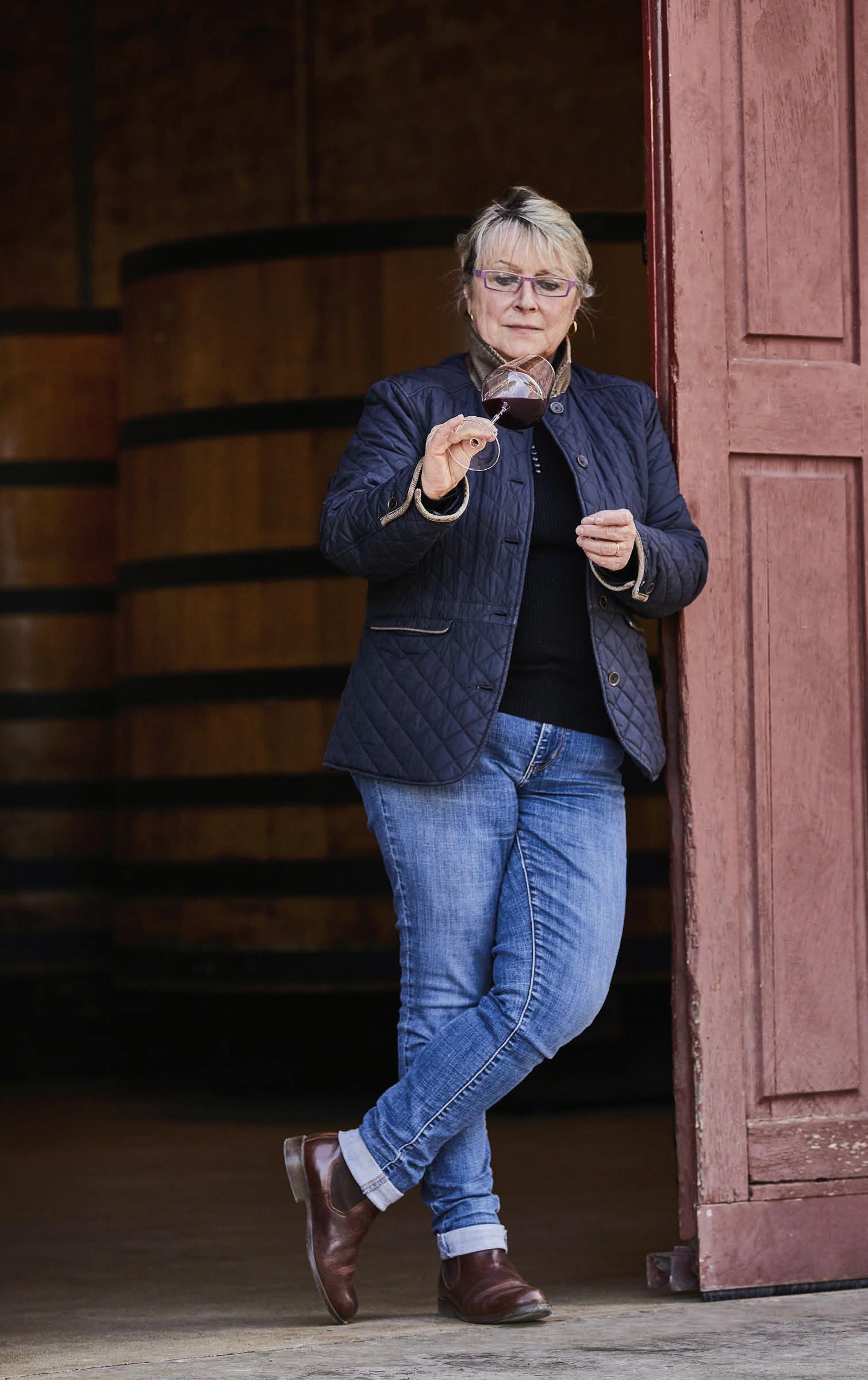
In her winemaking, scientific discipline coexists with poetic intuition. This unique synergy was recognized with her 1998 RVF award—an honor that signaled a paradigm shift in Burgundy.
1958年、ナディーヌ・ギュブ ランはフランス北東部、シャン パーニュ地方オーブ県の穀物農 家に生まれた。自然と隣り合わ せの環境で育った彼女は、幼い 頃から土地と生命とのつながり に敏感だった。
高校卒業後、ブルゴーニュ大 学の醸造学部へ進学。1970–1980年代のフランスでは、醸 造学を学ぶ女性はごく少数で、 彼女はその草分け的存在だっ た。微生物学や化学の重要性を 学ぶ中で、特に発酵における酵 母の役割に魅せられたという。
卒業後は、ブルゴーニュ南部マ コネ地区の醸造技術支援研究所 で勤務し、ボジョレーやマコネ のワイナリーを技術面で支援。 現場に根ざした技術者として、 彼女は「経験」と「分析」を橋 渡しする姿勢を身につけていっ た。
ジャック・プリウ ールとともに歩む 革新の30年
ギュブラン氏の名が世界に広く 知られるようになったのは、 1990年にドメーヌ・ジャック ・プリウールの醸造責任者に就 任してからだ。この名門ドメー ヌは、ムルソーを拠点に、モン ラッシェ、コルトン、エシェゾ ー、シャンベルタン、ミュジニ ーなどブルゴーニュを代表する グラン・クリュを多数所有して いる。
彼女は畑ごとの微気候や土壌の 特徴を綿密に分析し、区画ごと の醸造アプローチを導入。各テ ロワールの個性を余すところな く表現するスタイルを築き上げ た。
Copyright© Domaine Jacqus Prieur
また、収穫のタイミングを熟度 重視にシフトすることで、凝縮 感ある果実味とフィネスを両 立。自然重力を活かした醸造や 発酵温度の精密な管理など、 「ミクロへのこだわり」が随所 に光る。科学的な精密さと、土 地の声に耳を澄ませる詩的な感 受性。その両立こそが、1998 年の「年間最優秀醸造家賞」受 賞によって広く認められたギュ ブラン氏の真骨頂である。

Gublin continues to oversee winemaking at Domaine Jacques Prieur while also dedicating herself to education. As a board member of the Institut Jules Guyot at the University of Dijon, she guides students through every stage of winemaking—from soil analysis to fermentation and aging—through hands-on training.
Her influence extends globally. In 2023, one of her Chinese students made a groundbreaking discovery about native yeast in Puligny-Montrachet, publishing the findings in Nature Food.
A pioneer among women winemakers, Gublin has built networks with female vintners across France and beyond. She actively supports emerging talent and collaborates with high-end restaurants and sake brewers in Japan.
“Japanese craftsmanship reveres the spirit found in subtle detail,” she says. “That spirit resonates deeply with the soul of Burgundy.”
伝統と未来をつなぐ教育者としての顔
現在もドメーヌ・ジャック・プリウールで技術監修を続ける傍ら、ギュブラン氏は次 世代の育成にも力を注いでいる。ブルゴーニュ大学「ジュール・ゲイ研究所(Institut Jules Guyot)」の理事として、学生たちに実践的なワイン造りを教えている。
彼女の教育スタイルは理論だけにとどまらず、土壌調査から発酵、熟成に至るまで、実 際のワイナリーでの体験を重視する。こうした実践を通じて、多くの国際的な才能が彼 女のもとで育まれている。2023年には、中国人学生がピュリニー・モンラッシェの酵 母に関する画期的な発見をし、学術誌『Nature Food』に論文が掲載された。
As a pioneer for female winemakers, Gublin has earned wide respect for opening the path to women in the field. Since her 1998 accolade, she has built networks with female winemakers both in France and abroad, supporting talented young women in the industry.
Since the 2000s, she has actively expanded into Asian markets. Since 2005, she has collaborated with fine dining restaurants in Japan and deepened technical exchanges with sake brewers.
“Japanese artisans cherish the spirit found in details. That attitude resonates deeply with the craftsmanship of Burgundy,” she says.
Now 67, Nadine Gublin remains hands-on, tasting every vintage and ensuring quality with unwavering focus. Her life’s work reflects a deep and enduring dialogue with the land.
“Wine is a letter written by the land to the future. The winemaker is the postman who delivers it faithfully.”
In these words, one finds the essence of Gublin’s philosophy: a seamless blend of science and sensitivity, of terroir and time. Her life itself is a finely crafted expression of Burgundy’s soul.

科学者にして詩人— 風土を読み解く力
現在67歳のギュブラン氏は、いまなお全てのヴィン テージを自らの舌で確かめ、ワインの進化を見守って いる。その姿からは、彼女がどれほど真摯に土地と向 き合い続けてきたかがうかがえる。
「ワインとは、土地が未来に宛てて書く手紙。その手 紙を正しく届けるのが醸造家の役割です」。
そう語る彼女の姿には、土地と人、科学と感性をつな ぐ唯一無二の哲学がにじんでいる。その哲学から生ま れた知と感性は、いまや次の世代へと静かに受け継が れつつある。ワインという文化を未来へとつなぐ、そ の確かな足音は、ブルゴーニュの大地に今日も深く響 いている。
ギュブラン氏は、女性醸造家の道を切り拓いた先 駆者としても広く敬意を集めている。1998年の 受賞以降、国内外の女性醸造家とのネットワーク を築き、才能ある若手を支援してきた。
2000年代からはアジア市場への展開も積極的に 進めており、2005年以降は日本の高級レストラ ンとのコラボレーションや、日本酒造との技術交 流も深めている。
「日本の匠は、細部に宿る精神を尊ぶ。その姿勢 は、ブルゴーニュの職人魂と通じ合うものがある」 と、彼女は語る。


マキシム・フレデリックの菓子詩
In the refined world of haute pâtisserie—where precision becomes art and flavour becomes emotion—Maxime Frédéric speaks the language of pastry with clarity, depth, and elegance. Born in June 1989 in Normandy, Frédéric has become one of France’s most celebrated pastry chefs, crowned Pâtissier de l’Année by the Gault & Millau guide in 2022. Today, as Executive Pastry Chef of Cheval Blanc Paris, he crafts more than exquisite desserts—he cultivates a philosophy rooted in beauty, craftsmanship, and meaning.

精緻さが芸術となり、味わいが感情を呼び起こす——そんなオート・パティスリー(高級菓子)の世界で、 マキシム・フレデリック氏は深い感性と優雅さをもって菓子という言葉を紡ぎ出す。1989年6月、ノル マンディー生まれ。フランスでも屈指の才能として知られる彼は、2022年に『ゴ・エ・ミヨ』によって「 ペイストリー・シェフ パティシエ ・オブ・ザ・イヤー」賞に選ばれた。現在はシュヴァル・ブラン パリの ペストリーシェフとして、ただ美しいデザートを生み出すのではなく、「美しさ」「職人技」「意味」を 根底に捉えた哲学を、日々の仕事に込めている。
@PAQUOT_PauléeDePrintemps_Meursault2025
Frédéric’s creations are more than desserts; they are stories— quietly told through texture, form, and flavour. “What matters to me in the creative process is storytelling,” he says. “Everything has its meaning.” His signature millefeuille at Le Tout-Paris, the ethereal tiramisu at Langosteria, or the black and white rice dessert at Hakuba are all rooted in a narrative sensibility— elegant, personal, and precise.
One striking example of this storytelling is The Easter Bell, created for Easter 2025. A sculptural piece that celebrates tradition, it recalls Frédéric’s Normandy childhood, where bells, not rabbits, delivered chocolates on Easter morning. Molded from single-origin chocolate and designed to ring before being broken, it invites interaction. “There’s memory in that sound,” he says. “A ritual, an emotion.” It’s pastry as experience, where nostalgia and craftsmanship meet with grace.
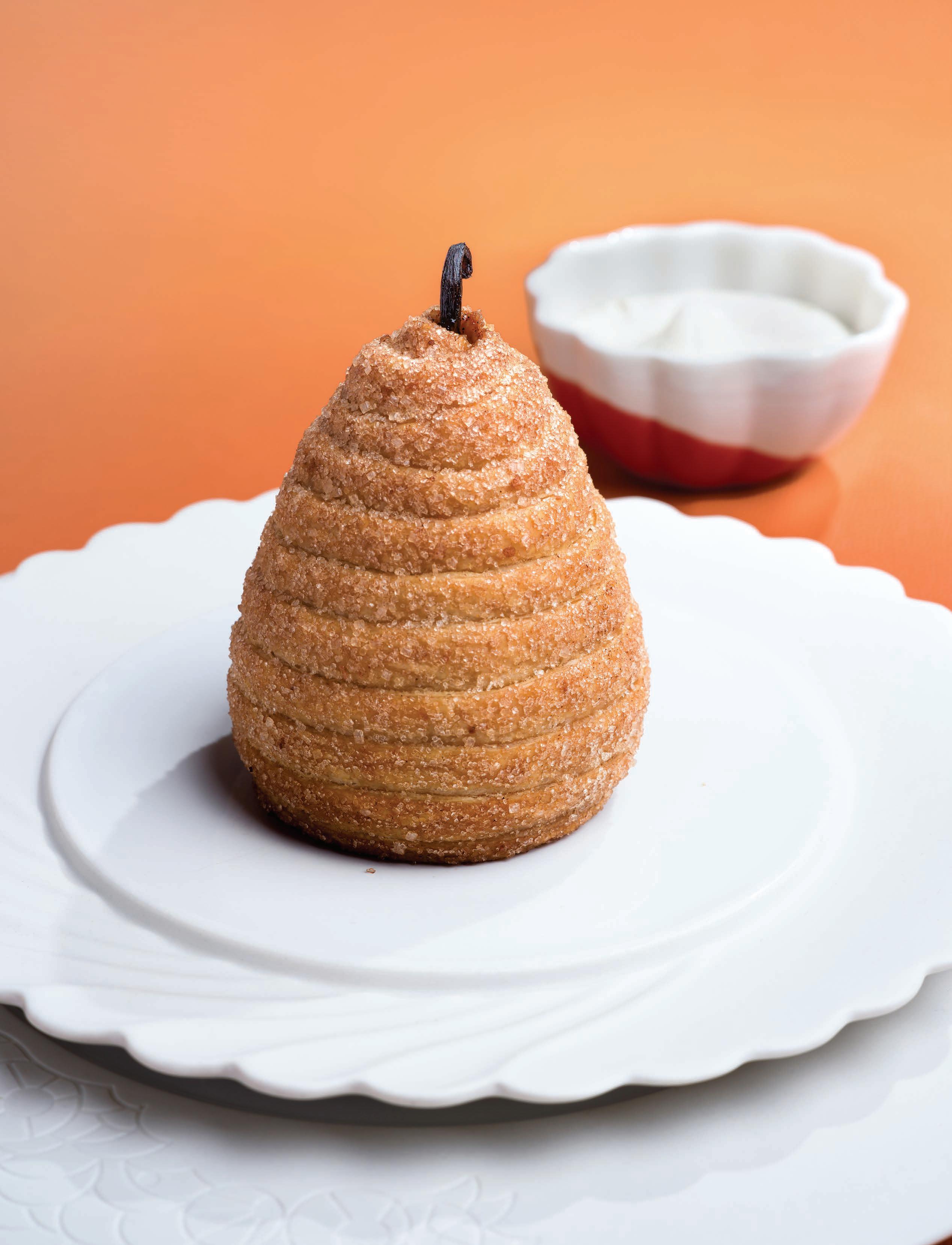
フレデリック氏の創作は、ただ のデザートではない。それは、 テクスチャー、形、風味を通じ て静かに語られる物語である。
「創作において私が大切にしてい るのは、物語性です。全てには 意味があります」と彼は語る。
「ル・トゥー パリ(Le ToutParis)」のシグネチャーである ミルフィーユ、「ランゴステリ ア(Langosteria)」の軽やかな ティラミス、あるいは「ハクバ (Hakuba)」で提供されるモノ クロのお米のデザート——いずれ も優雅で個人的、かつ精緻な物語 感覚に根ざしている。
その物語性を象徴する印象的な作 品のひとつが、2025年のイース ターに向けて制作された「THE EASTER BELL(イースター・ベ ル)」である。これは伝統を讃え る彫刻的な作品であり、イースタ ーの朝にチョコレートを届けてく れるのはウサギではなく鐘だった という、フレデリック氏のノルマ ンディーでの幼少期を思い起こさ せる。シングルオリジンチョコレ ートで成形されたこの作品は、割 る前に実際に「鳴らす」ことがで き、見る者に体験を促す。「その 音には記憶が宿っています。儀式 であり、感情なのです」と彼は語 る。それは、郷愁と職人技が優雅 に融合する、体験としてのパティ スリーである。
Frédéric’s inspiration is drawn from a diverse blend of cultures—Japanese purity, Italian warmth, and the essence of Paris—but it is always guided by what feels timeless. “I’m drawn to things that seem like they’ve always existed,” he says. “Not trends, but truths.” His creations embody a balance between tradition and reinterpretation, with a profound respect for culinary heritage and an innate sense of renewal.
Each of Frédéric’s pastries is a reflection of this philosophy— crafted with a monastic dedication to authenticity and balance. “Simplicity doesn’t mean minimal,” he explains. “It means essential.” From the flour to the butter, the fruit to the chocolate, every ingredient is selected not only with an artist’s eye but with a grower’s responsibility.
This connection to nature runs deep, shaping his approach to both work and life. Renewal comes not from distant luxury escapes, but from quiet, grounding rituals. Weekends spent with his partner, Claire, visiting farms, walking through hazelnut groves, and connecting with producers—these rhythms are what nourish his creativity. It’s in these moments, he says, that he finds the clarity to create.



る。
ひとつひとつの菓子は、 そうした哲学の結晶であ り、真摯で厳格なまでの こだわりとバランス感覚
この自然とのつながりは 彼の仕事や人生観の根幹 を成しており、その考え は深く根付いている。彼 にとって再生とは、日常 から離れた贅沢な逃避行 によってもたらされるの ではなく、静かで大地に 根ざした日常的な儀式の 中にある。パートナーの クレール氏と共に過ごす 週末、農園を訪れ、ヘー ゼルナッツの木立を歩き、 生産者と触れ合う。こう したリズムこそが、彼の 創造性を養っているので ある。

Maxime Frédéric is not merely reshaping pastry—he’s refining how we understand luxury. His work is an invitation to slow down, to feel deeply, and to savour what’s essential. He reminds us that elegance need not be loud, and that true mastery lies in restraint, reverence, and care.
In recent years, he has extended this ethos beyond the salons of Cheval Blanc Paris. With the opening of PleinCœur, a pâtisserie and boulangerie in the 17th arrondissement, he offers a more personal, grounded expression of his values—baking with technique, integrity, and above all, emotion.
Frédéric doesn’t aim to impress. He aims to move. To create moments that stay with you. And in the gentle resonance of his work—like the ring of a chocolate bell before it breaks—he reminds us: the most extraordinary things are often those made with intention, memory, and a full heart.

記憶に残る余韻
マキシム・フレデリック氏は、単にパティスリーを再定義しているのではない。彼は、 私たちが「ラグジュアリー」をどう捉えるかを刷新している。彼の作り出す作品は、立 ち止まり、深く感じ取り、本質を味わうための招待状的役割を果たしている。彼は、優 雅さとは決して声高ではなく、真の熟練とは、抑制と敬意、そして思いやりの中にある ことを思い出させてくれる。
近年では、彼はこの精神をシュヴァル・ブラン パリのサロンの外へと広げている。17 区にオープンしたパティスリー兼ブーランジュリー「プランクール(PleinCœur)」 では、技術と誠実さ、そして何よりも「感情」を込めて焼き上げるという、彼の価値観 をより個人的で地に足のついたかたちで表現している。
フレデリックが目指すのは、人を「感動させる」こと。決して「感心させる」ことでは ない。記憶に残るような一瞬を創り出すこと。そして、チョコレートの鐘が割れる前に 鳴る、あの柔らかな響きのように、彼は我々に思い出させてくれる。真に特別なものと は、いつだって「意図」と「記憶」と「真心」によって形づくられているのだと。
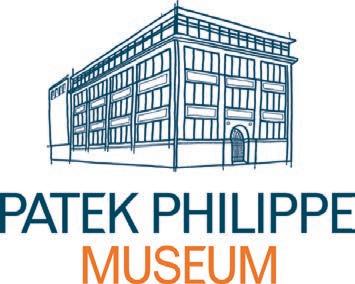






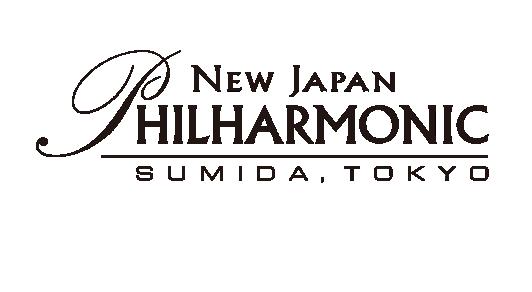





カリ デザイン・ディレクター ケリー マーケティング・ディレクター 伊藤 雄一 エグゼクティブ・ディレクター ハリザー
テキスト・エディター
藤真 唯
榎園 哲哉 マリア コルニエンコ
翻訳者
小林 芳友 本田 圭
アート責任者 ポリー
制作責任者 レナ
デジタル責任者 サイラス
写真提供者 ジュリアン・デュポン マテュー・ブランシャール
藤本 海斗
海外事業担当ディレクター イザベル・ジラール クリエイティブ・ディレクター セリーヌ・ルソー
編集長アシスタント
村上 衣吹 中村 靜
アシスタント
上田 美穂 中村 結衣 鈴木 葵 ジェシカ マーカス
Vosne-Romanée Culture & Art Center COMING SOON... ヴォーヌ・ロマネ文化芸術センター まもなくオープン…
インターン ジャーナリスト 吉本 圭中 佐藤 麗子 アレクサンダー・リード エミリー・トンプソン ノア・モーガン
